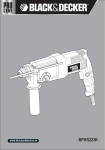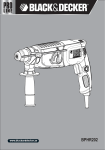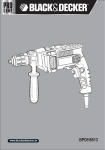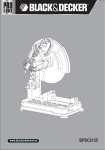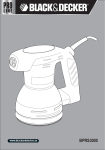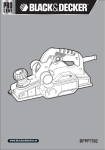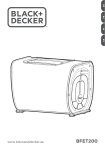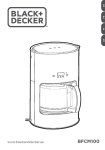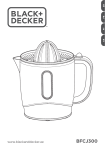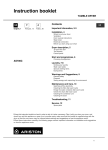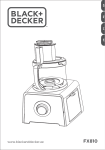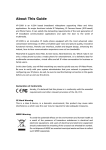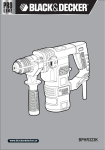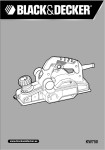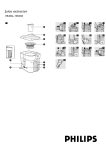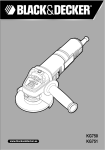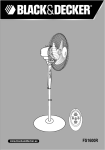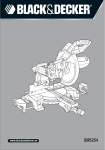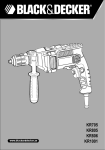Download Instruction Manual - Service
Transcript
www.blackanddecker.ae BPDH7213 ENGLISH 4 5 10 9 7 2 8 6 3 1 11 0000 0 0-00 A B 2 13 4 ENGLISH 7 6 C 12 D E 3 ENGLISH Intended use Your Black & Decker impact drill has been designed for drilling in wood, metal and concrete. This tool is intended for consumer use only. General Power tool Safety Warnings Warning! Read all safety warnings and all instructions. Failure to follow the warnings and instructions may result in electric shock, fire and/or serious injury. Save all warnings and instructions for future reference. The term "power tool" in all of the warnings listed below refers to your mains operated (corded) power tool or battery operated (cordless) power tool. 1. Work area safety a. Keep work area clean and well lit. Cluttered or dark areas invite accidents. b. Do not operate power tools in explosive atmospheres, such as in the presence of flammable liquids, gases or dust. Power tools create sparks which may ignite the dust or fumes. c. Keep children and bystanders away while operating a power tool. Distractions can cause you to lose control. 2. Electrical safety a. Power tool plugs must match the outlet. Never modify the plug in any way. Do not use any adapter plugs with earthed (grounded) power tools. Unmodified plugs and matching outlets will reduce risk of electric shock. b. Avoid body contact with earthed or grounded surfaces, such as pipes, radiators, ranges and refrigerators. There is an increased risk of electric shock if your body is earthed or grounded. c. Do not expose power tools to rain or wet conditions. Water entering a power tool will increase the risk of electric shock. d. Do not abuse the cord. Never use the cord for carrying, pulling or unplugging the power tool. Keep cord away from heat, oil, sharp edges or moving parts. Damaged or entangled cords increase the risk of electric shock. 4 e. When operating a power tool outdoors, use an extension cord suitable for outdoor use. Use of a cord suitable for outdoor use reduces the risk of electric shock. f. If operating a power tool in a damp location is unavoidable, use a residual current device (RCD) protected supply. Use of an RCD reduces the risk of electric shock. 3. Personal safety a. Stay alert, watch what you are doing and use common sense when operating a power tool. Do not use a power tool while you are tired or under the influence of drugs, alcohol or medication. A moment of inattention while operating power tools may result in serious personal injury. b. Use personal protective equipment. Always wear eye protection. Protective equipment such as dust mask, non-skid safety shoes, hard hat, or hearing protection used for appropriate conditions will reduce personal injuries. c. Prevent unintentional starting. Ensure the switch is in the off-position before connecting to power source and/or battery pack, picking up or carrying the tool. Carrying power tools with your finger on the switch or energising power tools that have the switch on invites accidents. d. Remove any adjusting key or wrench before turning the power tool on. A wrench or a key left attached to a rotating part of the power tool may result in personal injury. e. Do not overreach. Keep proper footing and balance at all times. This enables better control of the power tool in unexpected situations. f. Dress properly. Do not wear loose clothing or jewellery. Keep your hair, clothing and gloves away from moving parts. Loose clothes, jewellery or long hair can be caught in moving parts. g. If devices are provided for the connection of dust extraction and collection facilities, ensure these are connected and properly used. Use of dust collection can reduce dust-related hazards. ENGLISH 4. Power tool use and care Drill Safety Warnings a. Do not force the power tool. Use the correct power tool for your application. The correct power tool will do the job better and safer at the rate for which it was designed. • Wear ear protectors when impact drilling. Exposure to noise can cause hearing loss. • Use auxiliary handle(s), if supplied with the tool. Loss of control can cause personal injury. • Hold power tool by insulated gripping surfaces, when performing an operation where the cutting accessory may contact hidden wiring or its own cord. Cutting accessory contacting a "live" wire may make exposed metal parts of the power tool "live" and could give the operator an electric shock. • Use clamps or another practical way to secure and support the workpiece to a stable platform. Holding the work by hand or against your body leaves it unstable and may lead to loss of control. • Before drilling into walls, floors or ceilings, check for the location of wiring and pipes. • Avoid touching the tip of a drill bit just after drilling, as it may be hot. • This tool is not intended for use by persons(including children) with reduced physical, sensory or mental capabilities, or lack of experience and knowledge, unless they have been given supervision or instruction concerning use of the appliance by a person responsible for their safety. Children should be supervised to ensure that they do not play with the appliance. • The intended use is described in this instruction manual. The use of any accessory or attachment or performance of any operation with this tool other than those recommended in this instruction manual may present a risk of personal injury and/or damage to property. b. Do not use the power tool if the switch does not turn it on and off. Any power tool that cannot be controlled with the switch is dangerous and must be repaired. c. Disconnect the plug from the power source and/or the battery pack from the power tool before making any adjustments, changing accessories, or storing power tools. Such preventive safety measures reduce the risk of starting the power tool accidentally. d. Store idle power tools out of the reach of children and do not allow persons unfamiliar with the power tool or these instructions to operate the power tool. Power tools are dangerous in the hands of untrained users. e. Maintain power tools. Check for misalignment or binding of moving parts, breakage of parts and any other condition that may affect the power tool’s operation. If damaged, have the power tool repaired before use. Many accidents are caused by poorly maintained power tools. f. Keep cutting tools sharp and clean. Properly maintained cutting tools with sharp cutting edges are less likely to bind and are easier to control. g. Use the power tool, accessories and tool bits etc. in accordance with these instructions, taking into account the working conditions and the work to be performed. Use of the power tool for operations different from those intended could result in a hazardous situation. 5. Service Safety of others a. Have your power tool serviced by a qualified repair person using only identical replacement parts. This will ensure that the safety of the power tool is maintained. • This appliance is not intended for use by persons (including children) with reduced physical, sensory or mental capabilities, or lack of experience and knowledge, unless they have been given supervision or instruction concerning use of the appliance by a person responsible for their safety. • Children should be supervised to ensure that they do not play with the appliance. Additional Power Tool Safety Warnings Warning! Additional safety warnings for drills and impact drills 5 ENGLISH Residual risks When using a cable reel, always unwind the cable completely. Additional residual risks may arise when using the tool which may not be included in the enclosed safety warnings. These Also refer to the table below. risks can arise from misuse, prolonged use etc. Even with Conductor size (mm2) the application of the relevant safety regulations and the implementation of safety devices, certain residual risks can 0.75 not be avoided. These include: 1.00 • Injuries caused by touching any rotating/moving parts. 1.50 • Injuries caused when changing any parts, blades or accessories. • Injuries caused by prolonged use of a tool. When using any tool for prolonged periods ensure you take regular breaks. Cable rating (Amperes) 6 10 15 2.50 20 4.00 25 Cable length (m) 7.5 15 25 30 45 60 Voltage Amperes Cable rating (Amperes) 115 0 - 2.0 6 6 6 6 6 10 2.1 - 3.4 6 6 6 6 15 15 3.5 - 5.0 6 6 10 15 20 20 5.1 - 7.0 10 10 15 20 20 25 7.1 - 12.0 15 15 20 25 25 - 12.1 - 20.0 20 20 25 - - 0 - 2.0 6 6 6 6 6 6 Date code position (fig. A) 2.1 - 3.4 6 6 6 6 6 6 The date code (13) is printed on the housing of the tool, which also contains the year of manufacture. 3.5 - 5.0 6 6 6 6 10 15 5.1 - 7.0 10 10 10 10 15 15 For example: 7.1 - 12.0 15 15 15 15 20 20 12.1 - 20.0 20 20 20 20 25 - • Impairment of hearing. • Health hazards caused by breathing dust developed when using your tool (example:- working with wood, especially oak, beech and MDF.) Label on the tool The following symbols are shown on the tool: Warning! In order to reduce the risk of injury, the user must read the manual. 2014 XX JN Year of manufacture Electrical safety Double insulation measures are taken in this power tool, so no grounding is needed. Please check whether the voltage of power supplied is consistent with the voltage on the nameplate or not. • If the wire is damaged, it should be replaced by the manufacturer or a service center authorized by Black & Decker, to avoid danger. Using an extension cable If an extension cable is requred, use an approved extension cable suitable for the power input of this tool (see technical data). The minimum conductor size is 1.5 mm2. 6 230 Package contents The package contains: 1 Impact drill 1 Side handle 1 Depth gauge 1 Chuck key 1 Instruction manual • Check for damage to the tool, parts or accessories which may have occurred during transport. - ENGLISH • Take the time to thoroughly read and understand this manual prior to operation. Description (fig. A) 1. Variable speed switch • To remove the bit, proceed in reverse order. Fitting the side handle (fig. A) The side handle (6) can be fitted to suit both RH- and LH-users. 2. Lock-on button Always use the drill with the side handle properly assembled. 3. Forward/reverse slider 4. Mode selector • Loosen the side handle. 5. Ventilation slots • For RH-users, slide the side handle clamp overthe collar behind the chuck, handle at the left. • For LH-users, slide the side handle clamp overthe colar behind the chuck, handle at the right. • Rotate the side handle to the desired positionand tighten the handle. 6. Side handle 7. Depth adjustment rod 8. Keyed chuck 9. Sleeve 10. Chuck key Setting the drilling depth (fig. C) 11. Speed dail • Insert the required drill bit into the chuck. Assembly • Slacken the side handle (6). Warning! Before assembly, please ensure that the power tool is powered off and the power plug of the tool is unplugged from the power source. • Fit the depth adjustment rod (7) through the hole in the side handle clamp. • Adjust the drilling depth as shown. • Tighten the side handle. Selecting the operating mode (fig. B) The tool can be used in two operating modes: Rotary drilling: for steel, wood and plastics. Forward/reverse slider (fig. A) • Impact drilling: simultaneous rotating and impacting for concrete and masonry drilling operations. • Select the required operating mode by rotating the mode selector (4) to the required position. To select forward or reverse rotation, use the forward/reverse-switch (3) (see arrow on tool). Always wait until the motor has come to a complete standstill before changing the direction of rotation. Chuck removal (fig. D) Inserting and removing a bit (fig. A) Keyed chuck • Open the chuck jaws as far as possible • Open the chuck by turning the sleeve (9) counterclockwise and insert the bit shank. • Insert a screwdriver into the chuck and remove the chuck retaining screw (12) by turning clockwise. • Put the chuck key (10) into each hole in the side of the chuck and turn clockwise until tight. • Tighten an Allen key into the chuck and strike it with a hammer as shown. 7 ENGLISH Instructions for use • Always observe the safety instructions and applicable regulations. • Be aware of the location of pipework and wiring. • Apply only a gentle pressure to the tool. Excessive force does not speed up drilling but decreases tool performance and may shorten tool life. • Wear ear protectors with impact drills.Exposure to noise can cause hearing loss. • Use auxiliary handles supplied with the tool. Loss of control can cause personal injury. • Hold power tool by insulated gripping surfaces, when performing an operation where the cutting accessory may contact hidden wiring or its own cord. Cutting accessory contacting a "live" wire may make exposed metal parts of the power tool "live" and shock the operator. • If operating a power tool in a damp location is unavoidable, use a residual current device (RCD) protected supply. Use of an RCD reduces the risk of electric shock. Prior to operation • Insert the appropriate bit. • Mark the spot where the hole is to be drilled. Proper Hand Position (fig. A, E) Warning: To reduce the risk of serious personal injury, ALWAYS use proper hand position as shown. Warning: To reduce the risk of serious personal injury, ALWAYS hold securely in anticipation of a sudden reaction. Proper hand position requires one hand on the side handle (6), with the other hand on the main handle. • For continuous operation, press the lock-on button (2) and release the variable speed switch. This option is available only at full speed. • To switch the tool off, release the variable speed switch. To switch the tool off when in continuous operation, press the variable speed switch once more and release it. • Based on the different applications, turn around the speed dial (11) to control the maximum speed. Drilling in metal Start drilling with slow speed and increase to full power while applying firm pressure on the tool. A smooth even flow of metal chips indicates the proper drilling rate. Use a cutting lubricant when drilling metals. The exceptions are cast iron and brass which should be drilled dry. Note: Large [5/16" (8 mm) to 1/2" (13 mm)] holes in steel can be made easier if a pilot hole [5/32" (4 mm) to 3/16" (5 mm)] is drilled first. Drilling in wood Start drilling with slow speed and increase to full power while applying firm pressure on the tool. Holes in wood can be made with the same twist drills used for metal. These bits may overheat unless pulled out frequently to clear chips from the flutes. Work that is apt to splinter should be backed up with a block of wood. Drilling in masonry When drilling in masonry, use carbide-tipped bits rated for Impact drilling and be certain that the bits are sharp. Use a constant and firm force on the tool to drill most effectively. A smooth, even flow of dust indicates the proper drilling rate. Screwdriving • Select forward or reverse rotation. Impact drilling (fig. A) • Select the Impact mode. • Press the switch (1). Rotary drilling (fig. A) Switching on and off • Select the rotary drilling mode. • • Proceed as described for Impact drilling. Consult your dealer for further information on the appropriate accessories. To switch the tool on, press the variable speed switch (1). The tool speed depends on how far you press the switch. 8 ENGLISH Accessories The performance of an electric tool depends on its accessories. Black & Decker accessories are designed according to high quality standards, to enhance the performance of electric tool. The use of these accessories can help you conveniently operate the tool. Maintenance The Black & Decker cord / cordless appliance / tools are of sophisticated design, can be used for a long time, and only little maintenance is needed. To obtain consistent satisfactory use, proper maintenance and regular cleaning of the tools are necessary. other irritant chemicals. These chemicals may weaken the materials of these components. Use a cloth moistened with a mild soapy water to clean it. Do not let any substance permeate into the tool and.do not immerse any part of the tool into a liquid. Technical data Impact Drill BPDH7213 Power input W 720 Voltage V 220-240 Hz 50/60 Frequency No-load speed /min 0-3000 Warning! Before performing any maintenance work on the cord / cordless electric tools, the following points must be implemented: Impact rate IPM 0-54000 • Switch off the power of the equipment / tools and pull off the plug; Chuck capacity • If the equipment / tools are equipped with independent battery pack, please turn off the power and remove the battery pack from the equipment / tools. • If the equipment / tools are equipped with an integrated battery, please run out the battery, before turning off its power. • Before the cleaning, unplug the charger plug from the power source. In addition, except the regular cleaning on your charger, no other maintenance is needed. • Regularly use the soft brush or dry cloth to clean the ventilation slot of the equipment / tools / charger. • Regularly use a damp cloth to clean the motor housing. Please do not use any abrasive cleaning agents or solvent-based cleansing agents. • Regularly open the clamping chuck and tap it gently to remove any internal dust (after installation). Reverse/Forward rotation Yes mm 1.5-13 Concrete mm 16 Metal mm 13 Wood mm 32 Weight kg 2.5 Max capacity Cleaning Warning! Once the visible dust build-up is found at and/or around the ventilating ports, immediately flush the dust and powder within the host shell with clean dry air. To perform this procedure, wear the approved safety equipment and dust mask. Warning! It is strictly forbidden to clean the non-metallic parts of the tool with the solvents or 9 ENGLISH Protecting the environment Separate collection. This product must not be disposed of with normal household waste. Should you find one day that your Black & Decker product needs replacement, or if it is of no further use to you, do not dispose of it with household waste. Make this product available for separate collection. Separate collection of used products and packaging allows materials to be recycled and used again. Reuse of recycled materials helps prevent environmental pollution and reduces the demand for raw materials. Local regulations may provide for separate collection of electrical products from the household, at municipal waste sites or by the retailer when you purchase a new product. Black & Decker provides a facility for the collection and recycling of Black & Decker products once they have reached the end of their working life. To take advantage of this service please return your product to any authorised repair agent who will collect them on our behalf. You can check the location of your nearest authorised repair agent by contacting your local Black & Decker office at the address indicated in this manual. Alternatively, a list of authorised Black & Decker repair agents and full details of our after-sales service and contacts are available on the Internet at: www.2helpU.com. Service information Black & Decker offers a full network of company-owned and authorized service locations. All Black & Decker Service Centers are staffed with trained personnel to provide customers with efficient and reliable power tool service. For more information about our authorized service centers and if you need technical advice, repair, or genuine factory replacement parts, contact the Black & Decker location nearest you. Notes • Black & Decker’s policy is one of continuous improvement to our products and, as such, we reserve the right tochange product specifications without prior notice. • Standard equipment and accessories may vary by country. • Product specifications may differ by country. • Complete product range may not be available in all countries. Contact your local Black & Decker dealers for range availability. 10 Guarantee Black & Decker is confident of the quality of its products and offers an outstanding guarantee. This guarantee statement is in addition to and in no way prejudices your statutory rights. The guarantee is valid within the territories of the Member States of the European Union and the European Free Trade Area. If a Black & Decker product becomes defective due to faulty materials, workmanship or lack of conformity, within 12 months from the date of purchase, Black & Decker guarantees to replace defective parts, repair products subjected to fair wear and tear or replace such products to make sure of the minimum inconvenience to the customer unless: The product has been used for trade, professional or hire purposes. The product has been subjected to misuse or neglect. The product has sustained damage through foreign objects, substances or accidents. Repairs have been attempted by persons other than authorised repair agents or Black & Decker service staff. To claim on the guarantee, you will need to submit proof of purchase to the seller or an authorised repair agent. You can check the location of your nearest authorised repair agent by contacting your local Black & Decker office at the address indicated in this manual. Alternatively, a list of authorised Black & Decker repair agents and full details of our aftersales service and contacts are available on the Internet at: www.2helpU.com Please visit our website www.blackanddecker.ae to register your new Black & Decker product and to be kept up to date on new products and special offers. Further information on the Black & Decker brand and our range of products is available at www.blackanddecker.ae. FRANÇAIS 4 5 10 9 7 2 8 6 3 1 11 0000 0 0-00 A B 13 4 11 FRANÇAIS 7 6 C 12 D 12 E FRANÇAIS Utilisation prévue Votre perceuse à percussion Black & Decker a été conçue pour percer le bois, le métal et le béton. Cet outil est destiné à un usage privé uniquement. Consignes de sécurité concernant les outils électroportatifs. graves. Attention! Lire avec attention tous les avertissements et toutes les instructions. Le non-respect de cette consigne peut entraîner un choc électrique, un incendie et/ou des blessures Conservez tous les avertissements et instructions pour référence ultérieure. Le terme “outil électroportatif” mentionné dans les avertissements se rapporte à des outils raccordés au secteur (avec câble de raccordement) ou fonctionnant sur piles ou batterie. 1. Sécurité de la zone de travail a. Maintenez la zone de travail propre et bien éclairée. Un lieu de travail en désordre ou mal éclairé augmente le risque d'accidents. b. N'utilisez pas les outils électroportatifs dans un environnement présentant des risques d'explosion ni en présence de liquides, gaz ou poussières inflammables. Les outils électroportatifs génèrent des étincelles risquant d'enflammer les poussières ou les vapeurs. c. Pendant l’utilisation d’un outil électroportatif, les enfants et autres personnes doivent rester éloignés. En cas d'inattention, vous risquez de perdre le contrôle de l'outil. 2. Sécurité électrique a. La prise de l'outil électroportatif doit convenir à la prise de courant. Ne modifiez en aucun cas la prise. N'utilisez pas de prises d'adaptateur avec des appareils ayant une prise de terre. Le respect de ces consignes réduit le risque de choc électrique. pour le débrancher. Maintenez le câble éloigné des sources de chaleurs, des parties huilées, des bords tranchants ou des parties de l'appareil en rotation. Le risque de choc électrique augmente si les câbles sont endommagés ou emmêlés. e. Si vous utilisez l'outil électroportatif à l'extérieur, utilisez une rallonge homologuée pour utilisation à l'air libre. L'utilisation d'une rallonge électrique homologuée pour les travaux à l’extérieur réduit le risque de choc électrique. f. Si l’outil doit être utilisé dans un endroit humide, prenez des précautions en utilisant un dispositif à courant résiduel (RCD). L’utilisation d’un tel dispositif réduit les risques de chocs électriques. Remarque: Le terme “dispositif à courant résiduel (RCD)” peut être remplacé par “disjoncteur de fuite à la terre (GFCI)” ou par “interrupteur différentiel de sécurité (ELCB)”. 3. Sécurité personnelle a. Restez vigilant, surveillez ce que vous faites. Faites preuve de bon sens quand vous utilisez un outil électroportatif. N’utilisez pas l’outil lorsque vous êtes fatigué ou après avoir consommé de l’alcool ainsi que des médicaments. Un moment d'inattention lors de l'utilisation de l'outil peut entraîner de graves blessures. b. Portez un équipement de protection. Portez toujours des lunettes de protection. Selon le travail à effectuer, le port d'équipement de protection tels que masque anti-poussières, chaussures de sécurité antidérapantes, casque ou protection auditive, réduit le risque de blessures. c. Evitez un démarrage imprévu. L’appareil doit être en position OFF (arrêt) avant d’effectuer le branchement à l’alimentation électrique et/ou au bloc-batterie, et avant de le ramasser ou de le porter. Ne laissez pas votre doigt sur l’interrupteur de commande en le transportant et n’alimentez pas l’outil avec l’interrupteur en position de marche, cela pourrait être à l’origine d’accidents. d. Retirez tout outil ou clé de réglage avant de mettre l’outil en marche. Une clé ou un outil se trouvant sur une partie en rotation peut causer des blessures. b. Évitez le contact physique avec des surfaces mises à la terre telles que tuyaux, radiateurs, fours et réfrigérateurs. Le risque de choc électrique augmente si votre corps est relié à la terre. e. Adoptez une position confortable. Adoptez une position stable et gardez votre équilibre en permanence. Vous contrôlerez ainsi mieux l'outil dans des situations inattendues. c. N'exposez pas l'outil électroportatif à la pluie ni à l'humidité. La pénétration d'eau dans un outil électroportatif augmente le risque de choc électrique. f. Portez des vêtements appropriés. Ne pas porter de vêtements flottants ou de bijoux. N’approchez pas les cheveux, vêtements ou gants des parties des pièces mobiles. Les vêtements amples, les bijoux ou les cheveux longs peuvent être attrapés dans les pièces en mouvement. d. Préservez le câble d'alimentation. N'utilisez pas le câble pour porter l'outil, pour l'accrocher ou encore 13 FRANÇAIS g. En cas d’utilisation d’appareils servant à aspirer ou à recueillir les poussières, assurez-vous qu’ils sont correctement raccordés et utilisés. L'utilisation de tels appareils permet de réduire les dangers liés aux poussières. 4. Utilisation des outils électroportatifs et précautions a. Respectez la capacité de l'outil. Utilisez l'outil électroportatif approprié pour le travail à effectuer. Avec un outil approprié, vous travaillerez mieux et en toute sécurité. b. N’utilisez pas un outil électroportatif dont l’interrupteur marche/arrêt est défectueux. Un outil électroportatif qui ne peut plus être mis en marche ou arrêter est dangereux et doit être réparé. c. Retirez la prise de courant et/ou débranchez le blocbatterie avant d'effectuer des réglages, de changer les accessoires ou de ranger l'outil. Cette mesure de précaution empêche de mettre l’outil en marche accidentellement. d. Rangez les outils électroportatifs hors de portée des enfants. Les personnes ne connaissant pas l’outil ou n’ayant pas lu ces instructions ne doivent en aucun cas l’utiliser. Les outils électroportatifs sont dangereux lorsqu'ils sont utilisés par des personnes non initiées. e. Prenez soin des outils électroportatifs. Vérifiez que les parties en mouvement fonctionnent correctement et qu'elles ne sont pas coincées. Vérifiez qu'il n’y a pas de pièces cassées ou endommagées susceptibles de nuire au bon fonctionnement de l'outil. S’il est endommagé, faites réparer l’outil avant de l’utiliser. De nombreux accidents sont la conséquence d’outils mal entretenus. f. Maintenez les outils de coupe aiguisés et propres. Des outils soigneusement entretenus avec des bords tranchants bien aiguisés se coincent moins souvent et peuvent être guidés plus facilement. L’utilisation des outils électroportatifs à d’autres fins que celles prévues peut entraîner des situations dangereuses. g. Utilisez l’outil électrique, les accessoires et les forets etc., conformément aux présentes directives et en tenant compte des conditions de travail et du travail à effectuer. L’utilisation d’un outil électrique à d’autres fins que celles prévues peut entraîner des situations dangereuses. Consignes de sécurité supplémentaires pour les outils électriques Attention! Consignes de sécurité supplémentaires pour les perceuses et les perceuses à percussion Consignes de sécurité pour les perceuses • Portez des protège-oreilles lorsque vous utilisez une perceuse à percussion. Une exposition au bruit peut entraîner des lésions auditives. • Utilisez la/les poignée(s) auxiliaire(s), si elle(s) est/sont fournie(s) avec l’outil. La perte de contrôle peut entraîner des blessures corporelles. • Tenez l’outil par les surfaces de prise isolées lorsque vous l’utilisez pour un travail risquant de le mettre en contact avec des fils électriques cachés ou son propre câble d’alimentation. En touchant un fil sous tension, la charge électrique passe dans les parties métalliques de l’outil électrique exposant l’utilisateur à un choc électrique. • Utilisez des pinces de serrage ou tout autre dispositif de fixation pour sécuriser la pièce à usiner sur un support stable. Tenir la pièce à usiner à la main ou contre son corps la rend instable et peut conduire à une perte de contrôle. • Avant de percer un mur, un plancher ou un plafond, vérifiez l’emplacement des fils électriques et des tuyaux. • Evitez de toucher la pointe d’un foret juste après le perçage car il peut être chaud. • Cet outil ne peut pas être utilisé par des personnes (y compris les enfants) ayant des capacités physiques, sensorielles ou mentales réduites, ou par des personnes manquant d’expérience et de connaissances, à moins qu’elles ne soient encadrées ou qu’elles n’aient été formées à l’utilisation de l’outil par une personne responsable de leur sécurité. Ne laissez pas les enfants sans surveillance pour éviter qu’ils ne jouent avec l’appareil. • Ce manuel d’instructions décrit comment utiliser cet outil. L’utilisation d’un accessoire ou d’un élément annexe, ou l’utilisation de cet appareil à d’autres fins que celles recommandées dans ce manuel d’instructions peut entraîner des blessures et/ou des dommages matériels. Sécurité d’autrui • Cet appareil ne peut pas être utilisé par des personnes (y compris les enfants) ayant des capacités physiques, sensorielles ou mentales réduites, ou par des personnes manquant d’expérience et de connaissances, à moins qu’elles ne soient encadrées ou qu’elles n’aient été formées à l’utilisation de l’appareil par une personne responsable de leur sécurité. • Ne laissez pas les enfants sans surveillance pour éviter qu’ils ne jouent avec l’appareil. 5. Réparations a. Faites réparer votre outil électroportatif uniquement par du personnel qualifié et seulement avec des pièces de rechange appropriées. La fiabilité de l’outil sera ainsi maintenue. 14 FRANÇAIS Risques résiduels Des risques résiduels supplémentaires pouvant survenir lors de l’utilisation d’un outil, peuvent ne pas être mentionnés dans les présentes règles de sécurité. Ces risques peuvent découler d’une mauvaise utilisation, d’une utilisation prolongée de l’outil, etc. Même en respectant les consignes de sécurité applicables et en utilisant des dispositifs de sécurité, certains risques résiduels ne peuvent pas être évités. Sont inclus: Si vous utilisez un enrouleur de câble, déroulez toujours le câble entièrement. Reportez-vous aussi au tableau ci-dessous. Taille des conducteurs (mm2) Tension nominale du câble (ampères) 0.75 6 1.00 10 • Blessures causées en touchant les parties mobiles ou en rotation. 1.50 15 2.50 20 • Blessures causées lors du changement de pièces, de lames ou d’accessoires. 4.00 25 • Blessures causées par l’utilisation prolongée d’un outil. Si vous devez utiliser un outil pendant de longues périodes, pensez à prendre des pauses régulièrement. • Troubles auditifs. • Risques pour la santé causés par l’inhalation de poussières dégagées lors de l’utilisation de votre outil (exemple:- travail du bois, surtout le chêne, l’hêtre et le MDF.) Longueur du câble (m) 7.5 15 25 30 45 60 Tension Ampères Tension nominale du câble (ampères) 115 0 - 2.0 6 6 6 6 6 10 2.1 - 3.4 6 6 6 6 15 15 3.5 - 5.0 6 6 10 15 20 20 5.1 - 7.0 10 10 15 20 20 25 7.1 - 12.0 15 15 20 25 25 - 12.1 - 20.0 20 20 25 - - Etiquettes apposées sur l’outil Les pictogrammes suivants sont affichés sur l’outil: Attention! Pour réduire le risque de blessure, l’utilisateur doit lire le manuel d’instructions. 230 Emplacement du code de production (fig. A) Le code de production (13) est imprimé sur le boîtier de l’outil, ainsi que l’année de fabrication. Par exemple: 2014 XX JN Année de fabrication Sécurité électrique Cet outil est doublement isolé, par conséquent, aucun câble de mise à la terre n’est nécessaire. Vérifiez bien que la tension secteur correspond à celle indiquée sur la plaque signalétique. • Si le câble d’alimentation est endommagé, il doit être remplacé par le fabricant ou par un centre de réparation Black & Decker agréé de façon à éviter tout danger. - 0 - 2.0 6 6 6 6 6 6 2.1 - 3.4 6 6 6 6 6 6 3.5 - 5.0 6 6 6 6 10 15 5.1 - 7.0 10 10 10 10 15 15 7.1 - 12.0 15 15 15 15 20 20 12.1 - 20.0 20 20 20 20 25 - Contenu de l’emballage L’emballage contient: 1 Perceuse à percussion 1 Poignée latérale 1 Jauge de profondeur Utilisation d’un câble prolongateur 1 Clé de mandrin Lorsque l’utilisation d’un câble prolongateur est nécessaire, utilisez un câble prolongateur approuvé dont la puissance nominale correspond à l’outil (voir les données techniques). La taille minimale du conducteur est de 1,5 mm2. 1 Guide utilisateur • Vérifiez que l’outil, les accessoires ou les éléments annexes sont en bon état et n’ont pas été endommagés pendant le transport. 15 FRANÇAIS • Prenez le temps de lire attentivement le manuel et d’en comprendre les termes avant toute utilisation. Description (fig. A) 1. Interrupteur de vitesse variable • Installation de la poignée latérale (fig. A) La poignée latérale (6) peut être montée pour convenir aux droitiers ou aux gauchers. 2. Bouton de verrouillage 3. Bouton de commande avant/arrière 4. Sélecteur de mode de perçage 5. Fentes d’aération Toujours utiliser la perceuse avec la poignée latérale correctement montée. • Desserrer la poignée latérale. • Pour les droitiers, insérer l’attache de la poignée latérale par dessus le collier derrière le mandrin, poignée à gauche. • Pour les gauchers, insérer l’attache de la poignée latérale par dessus le collier derrière le mandrin, poignée à droite. • Faites tourner la poignée latérale dans la position souhaitée puis serrer la poignée. 6. Poignée latérale 7. Tige de réglage de profondeur 8. Mandrin à clé 9. Manchon 10. Clé de mandrin 11. Cadran de vitesse Assemblage Attention! Avant l’assemblage, assurez-vous que l’outil est éteint et débranché. Sélection du mode de fonctionnement (fig. B) L’outil permet deux modes de fonctionnement: Perçage rotatif: pour l’acier, le bois et le plastique. Perçage à percussion: perçage rotatif et à percussion simultanés pour les matériaux de construction et le béton. • Sélectionnez le mode de perçage souhaité en tournant le sélecteur de mode de perçage (4) sur la position souhaitée. Installation ou retrait d’un foret (fig. A) Mandrin à clé • Ouvrir le mandrin en tournant le manchon (9) dans le sens antihoraire et insérer l’embout du foret. • Insérer la clé à mandrin (10) dans chaque trou situé sur le côté du mandrin et serrer en tournant dans les sens horaire. 16 Pour enlever le foret, procédez dans le sens inverse. Réglage de la profondeur de perçage (fig. C) • Insérer le foret requis dans le mandrin. • Desserrer la poignée latérale (6). • Passer la tige de réglage de profondeur (7) dans le trou de l’attache de la poignée latérale. • Régler la profondeur de perçage comme indiqué. • Serrer la poignée latérale. Bouton de commande avant/arrière (fig. A) • Pour sélectionner le sens de rotation, utiliser le bouton de commande avant/arrière (3) (voir flèche sur l’outil). Toujours attendre l’arrêt complet du moteur avant de changer le sens de rotation. Retrait du mandrin (fig. D) • Ouvrir les mors du mandrin le plus possible • Insérer un tournevis dans le mandrin et enlever la vis de retenue du mandrin (12) en tournant dans le sens horaire. • Serrer une clé Allen dans le mandrin et frappez-le avec un marteau comme indiqué. FRANÇAIS Mode d’emploi • Respectez toujours les consignes de sécurité et les règles applicables. • Vérifiez l’emplacement des tuyaux et des fils électriques. • Exercez seulement une légère pression sur l’outil. En exerçant une forte pression sur l’outil vous n’accélérez pas la vitesse du perçage mais vous ralentissez les performances de l’outil et réduisez son temps de vie. • Portez des protège-oreilles lorsque vous utilisez le mode percussion. L’exposition au bruit peut entraîner des lésions auditives. • Utilisez les poignées latérales fournies avec l’outil. La perte de contrôle peut entraîner des blessures corporelles. • Tenez l’outil par les surfaces de prise isolées lorsque vous l’utilisez pour un travail risquant de le mettre en contact avec des fils électriques cachés ou son propre câble. En touchant un fil sous tension, la charge électrique passe dans les parties métalliques de l’outil électrique exposant l’utilisateur à un choc électrique. • Si l’outil doit être utilisé dans un endroit humide, utilisez un dispositif à courant résiduel (RCD). L’utilisation d’un RCD réduit les risques de chocs électriques. Avant le fonctionnement • Insérer le foret approprié. • Marquer l’endroit ou le trou doit être percé. Position correcte des mains (fig. A, E) Attention: Pour réduire le risque de blessures graves, TOUJOURS utiliser la position des mains comme indiqué. Attention: Pour réduire le risque de blessures graves, TOUJOURS tenir l’outil fermement en prévision d’une réaction soudaine. • Pour un fonctionnement en continu, appuyez sur le bouton de verrouillage (2) et relâchez l’interrupteur de vitesse variable. Cette option n’est disponible qu’en vitesse maximale. • Pour éteindre l’outil, relâchez le sélecteur de vitesse. Pour éteindre l’outil lorsqu’il est en fonctionnement continu, appuyez sur l’interrupteur de vitesse variable une fois de plus et relâchez-le. • Suivant les différentes applications, tournez le cadran de vitesse (11) pour contrôler la vitesse maximale. Percer dans le métal Commencer à percer avec une vitesse lente puis augmenter la puissance jusqu’à la vitesse maximale tout en exerçant une pression ferme sur l’outil. Un léger flux régulier de copeaux de métal indique une bonne vitesse de perçage. Utiliser un lubrifiant de coupe lorsque vous percer du métal, à l’exception de la fonte et du laiton qui doivent être percés à sec. Remarque: Il est plus facile de percer des trous larges [de 5/16" (8 mm) à 1/2" (13 mm)] dans l’acier après avoir d’abord percé un trou pilote [de 5/32" (4 mm) à 3/16" (5 mm)]. Percer dans le bois Commencer à percer avec une vitesse lente puis augmenter la puissance jusqu’à la vitesse maximale tout en exerçant une pression ferme sur l’outil. Il est possible d’utiliser les mêmes forets pour le bois que pour le métal. Ces forets risquent de surchauffer à moins d’enlever fréquemment les copeaux des cannelures. Un perçage qui risque de faire éclater le bois nécessite un bloc de bois comme support arrière. Percer dans un matériau de construction Lorsque vous devez percer dans un matériau de construction, utilisez des forets à pointe carbure adaptés pour le perçage à percussion et assurez-vous qu’ils sont bien aiguisés. Exercez une force constante et ferme sur l’outil pour percer plus efficacement. Un léger flux régulier de poussière indique une bonne vitesse de perçage. Une position correcte des mains requiert une main sur la poignée latérale (6), et l’autre main sur la poignée principale. Vissage Démarrage et arrêt Perçage à percussion (fig. A) • • Sélectionner le mode de perçage à percussion. • Appuyez sur l’interrupteur (1). Pour mettre l’outil en marche, appuyez sur l’interrupteur de vitesse variable (1). La vitesse de l’outil dépend de la force que vous exercez sur l’interrupteur. • Sélectionner le sens de rotation avant ou arrière. 17 FRANÇAIS Nettoyage Perçage rotatif (fig. A) • Sélectionner le mode de perçage rotatif. • Procéder comme pour le perçage à percussion. Consulter votre revendeur pour de plus amples informations sur les accessoires appropriés. Accessoires Attention! Lorsqu’une accumulation de poussière est visible sur et autour des fentes d’aération, enlevez immédiatement cette poussière à l’aide d’un souffleur d’air sec. Pour effectuer cette procédure, portez un équipement de sécurité approuvé et un masque anti-poussière. Attention! Il est formellement interdit de nettoyer les parties non métalliques de l’outil avec des Les performances d’un outil électrique dépendent des solvants ou tout autre produit chimique irritant. accessoires utilisés. Les accessoires Black & Decker sont Ces produits chimiques pourraient affaiblir les conçus selon les normes de haute qualité pour améliorer les matériaux de ces parties. Utilisez un chiffon humidifié avec performances de votre outil électrique. En utilisant ces de l’eau savonneuse pour nettoyer l’outil. Ne laissez aucune accessoires, vous obtiendrez les meilleurs résultats de votre substance pénétrer à l’intérieur de l’outil et n’immergez outil. aucune partie de l’outil dans un liquide. Entretien Les outils Black & Decker avec ou sans fil sont des appareils de conception sophistiquée et peuvent fonctionner pendant longtemps avec un minimum d’entretien. Un fonctionnement continu satisfaisant dépend d’un nettoyage régulier et d’un entretien approprié de l’outil. Attention! Avant d’effectuer toute opération d’entretien sur les outils électriques avec ou sans fil, il est important de respecter les points suivants: Données techniques Perceuse à percussion Puissance nominale W 720 Tension V 220-240 Hz 50/60 Vitesse à vide /min 0-3000 Fréquence de frappe IPM 0-54000 Courant d’alimentation • Eteindre l’appareil/l’outil puis débranchez-le; Rotation avant/arrière • Si l’appareil/l’outil est muni d’un bloc-batterie séparé, éteignez l’appareil et retirez la batterie de l’appareil/l’outil. Capacité mandrin • Si l’appareil/l’outil possède une batterie intégrée, déchargez complètement la batterie avant d’éteindre l’appareil. • Débranchez le chargeur avant de le nettoyer. Aucun entretien particulier n’est nécessaire pour le chargeur en dehors du nettoyage régulier. • Nettoyez régulièrement les fentes d’aération de votre appareil/outil/chargeur à l’aide d’une brosse souple ou d’un chiffon sec. • Nettoyez régulièrement le compartiment du moteur à l’aide d’un chiffon humide. N’utilisez pas de produit abrasif ou à base de solvant. • Ouvrez régulièrement le mandrin et retirez la poussière à l’intérieur en le secouant doucement (si installé). 18 BPDH7213 Oui mm 1,5-13 Capacité max. Béton mm 16 Métal mm 13 Bois mm 32 Poids kg 2,5 FRANÇAIS Protection de l'environnement Recyclage. Cet appareil ne doit pas être jeté avec les déchets ménagers. Si votre appareil Black & Decker doit être remplacé ou si vous n'en avez plus l'usage, ne le jetez pas avec les ordures ménagères. Songez à la protection de l'environnement et recyclez-les. La collecte séparée des produits et des emballages usagés permet de recycler et de réutiliser des matériaux. La réutilisation de matériaux recyclés évite la pollution de l'environnement et réduit la demande de matières premières. Des réglementations locales peuvent stipuler la collecte séparée des produits électriques et des produits ménagers, dans des déchetteries municipales ou par le revendeur lorsque vous achetez un nouveau produit. Black & Decker offre une solution permettant de recycler les produits Black & Decker lorsqu'ils ont atteint la fin de leur cycle de vie. Pour pouvoir profiter de ce service, veuillez retourner votre produit à un réparateur agréé qui se chargera de le collecter pour nous. Pour connaître l'adresse du réparateur agréé le plus proche de chez vous, contactez le bureau Black & Decker à l'adresse indiquée dans ce manuel. Vous pourrez aussi trouver une liste de réparateurs agréés de Black & Decker et de plus amples détails sur notre service après-vente sur le site Internet à l'adresse suivante : www.2helpU.com. Informations sur le service après-vente Black & Decker offre un large réseau de centres de service Black & Decker ou agréés partout en Asie. Tous les centres de services Black & Decker sont dotés d’un personnel qualifié afin de garantir aux clients une qualité et une fiabilité de service dans la réparation de leurs outils. Que vous ayez besoin de conseils techniques, de réparation ou de pièces de rechange d’origine, il suffit de contacter le centre Black & Decker le plus proche. Remarques • Black & Decker mène une politique d’amélioration continue de ses produits et se réserve, de ce fait, le droit d’en modifier les caractéristiques sans préavis. • Les équipements d’origine et les accessoires peuvent varier d’un pays à l’autre. • Les caractéristiques d’un produit peuvent varier d’un pays à l’autre. • La gamme complète des produits peut ne pas être offerte dans tous les pays. Contactez votre revendeur Black & Decker pour connaître la disponibilité de la gamme. Garantie Black & Decker vous assure la qualité de ses produits et vous offre une garantie très étendue. Ce certificat de garantie est un document supplémentaire et ne peut en aucun cas se substituer à vos droits légaux. La garantie est valable sur tout le territoire des États Membres de l'Union Européenne et de la Zone de Libre Échange Européenne. Si un produit Black & Decker s'avère défectueux en raison de matériaux en mauvais état, d'une erreur humaine, ou d'un manque de conformité dans les 12 mois suivant la date d'achat, Black & Decker garantit le remplacement des pièces défectueuses, la réparation des produits usés ou cassés ou remplace ces produits à la convenance du client, sauf dans les circonstances suivantes : Le produit a été utilisé dans un but commercial, professionnel, ou a été loué. Le produit a été mal utilisé ou avec négligence. Le produit a subi des dommages à cause de corps étrangers, de substances ou d'accidents. Des réparations ont été tentées par des techniciens ne faisant pas partie du service technique de Black & Decker. Pour avoir recours à la garantie, il est nécessaire de fournir une preuve d'achat au vendeur ou à un réparateur agréé. Pour connaître l'adresse du réparateur agréé le plus proche de chez vous, contactez le bureau Black & Decker à l'adresse indiquée dans ce manuel. Vous pourrez aussi trouver une liste de réparateurs agréés de Black & Decker et de plus amples détails sur notre service après-vente sur le site Internet à l'adresse suivante : www.2helpU.com Visitez notre site Web www.blackanddecker.ae pour enregistrer votre nouveau produit Black & Decker et être informé des nouveaux produits et des offres spéciales. Pour plus d'informations concernant la marque Black & Decker et notre gamme de produits, consultez notre site www.blackanddecker.ae. 19 Arabic ¿Éª°†dG ¿É«H ¿ƒµjh .kGõ«‡ Ék fɪ°V Ωó≤Jh É¡JÉéàæe IOƒéH ôµjO ófBG ∑ÓH ≥ãJ ¥ƒ≤◊ÉH ∫GƒMC’G øe ∫ÉM …CÉH πîj ’h áaÉ°VE’ÉH Gòg ¿Éª°†dG OÉ–E’G ‘ AÉ°†YC’G ∫hódG º«∏bEG πNGO ¿Éª°†dG Gòg …öùjh .á«fƒfÉ≤dG .á«HhQhC’G Iô◊G IQÉéàdG á≤£æeh »HQhC’G áYÉæ°üdGh OGƒŸG ܃«Y ÖÑ°ùH Ék Ñ«©e ôµjO ófBG ∑ÓH èàæe íÑ°UCG GPEG ïjQÉJ øe kGô¡°T 12 ¿ƒ°†Z ‘ ôµjO ófBG ∑ÓH øª°†J ,á≤HÉ£ŸG ΩóYh »∏ÑdG IÉYGôe ™e äÉéàæŸG ìÓ°UEGh áÑ«©ŸG AGõLC’G ∫GóÑà°SG AGöûdG AÓª©dG É°VQ øe ócCÉà∏d äÉéàæŸG √òg ∫GóÑà°SG hCG …OÉ©dG ΩGóîà°S’ÉH :⁄ Ée .ÒLCÉà∏d hCG á«æ¡e hCG ájQÉŒ ¢VGôZC’ èàæŸG ΩGóîà°SG ” .èàæŸG ΩGóîà°SG IAÉ°SEG hCG ∫ɪgEG .çOGƒ◊G hCG á«HôZ ¢VGôZCG hCG OGƒe ÖÑ°ùH ∞∏àd èàæŸG ¢Vô©J øjôNB’G ¢UÉî°TC’G πÑb øe ìÓ°UE’G äÉ«∏ªY AGôLEG ádhÉfi ∑ÓÑd ™HÉàdG áeóÿG ≥jôa hCG º¡H ìöüŸG ìÓ°UE’G AÓch ±ÓîH .ôµjO ófBG ™«ÑdG π«ch hCG ™FÉÑ∏d AGöûdG äÉÑKEG Ëó≤J Öéj ,¿Éª°†dÉH áÑdÉ£ª∏d Öàµe á©LGôà óªà©e ìÓ°UEG π«ch ÜôbCG ¿Éµe áaô©e ∂æµÁh .óªà©ŸG ôaƒàJ ɪc .π«dódG ‘ ¬«dEG QÉ°ûŸG ¿Gƒæ©dG ‘ »∏ëŸG ôµjO ófBG ∑ÓH äÉeóN äÉfÉ«Hh ôµjO ófBG ∑ÓH iód øjóªà©ŸG ìÓ°UE’G AÓcƒH áªFÉb :ÊhεdE’G ™bƒŸG ≈∏Y ∫É°üJ’Gh ™«ÑdG ó©H Ée .www.2helpU.com www.blackanddecker.ae ÊhεdE’G Éæ©bƒe á©LGôe ≈Lôj äÉéàæŸG çóMCG áaô©Ÿh ôµjO ófBG ∑ÓH øe ójó÷G ∂éàæe π«é°ùàd áeÓY ∫ƒM äÉeƒ∏©ŸG øe ójõŸG ≈∏Y ∫ƒ°üë∏dh .á°UÉÿG ¢Vhô©dGh IQÉjR ≈Lôj ,ÉæJÉéàæeh ôµjO ófBG ∑ÓH .www.blackanddecker.ae 20 Arabic áÄ«ÑdG ájɪM .á«dõæŸG äÉØ∏îŸG ™e èàæŸG Gòg AÉ≤dEG ΩóY Öéj .π°üØæe ™«ªŒ ∂H ¢UÉÿG ôµjO ófBG ∑ÓH RÉ¡L πjóÑJ Öéj ¬fCÉH ΩÉjC’G óMCG ‘ ∂d ÚÑJ GPEG ºbh .á«dõæŸG äÉØ∏îŸG ™e ¬æe ¢ü∏îàJ ’ .¬eGóîà°S’ áLÉëH ó©J ⁄ hCG .π°üØæŸG ™«ªéà∏d èàæŸG Gòg ÒaƒàH øe áeóîà°ùŸG äGƒÑ©dGh äÉéàæª∏d π°üØæŸG ™«ªéàdG øµÁ IOÉYEG óYÉ°ùj PEG ,iôNCG Iôe É¡eGóîà°SGh OGƒŸG ôjhóJ IOÉYEG ≈∏Y Ö∏£dG ¢†ØNh »Ä«ÑdG çƒ∏àdG ™æe ≈∏Y ÉgôjhóJ OÉ©ŸG OGƒŸG ΩGóîà°SG ΩÉÿG OGƒŸG øY á«FÉHô¡µdG äÉéàæª∏d π°üØæe ™«ªŒ ≈∏Y á«∏ëŸG äÉ©jöûàdG ¢üæJ ób AGöT óæY áFõéàdG ôLÉJ hCG ájó∏ÑdG äÉØ∏fl ™bGƒe ‘ á«dõæŸG äÉØ∏îŸG .ójóL èàæe ôµjO ófBG ∑ÓH äÉéàæe ôjhóJ IOÉYEGh ™«ªéàd ICÉ°ûæe ôµjO ófBG ∑ÓH ôaƒJ √òg øe IOÉØà°SÓdh .™aÉædG ÉgôªY ájÉ¡æd äÉéàæŸG ∂∏J ∫ƒ°Uh óæY Ωƒ≤«°S …òdG óªà©e ìÓ°UEG π«ch …CG ¤EG èàæŸG IOÉYEG ≈Lôj ,áeóÿG .ÉæY áHÉ«f äÉéàæŸG ™«ªéàH ôµjO ófBG ∑ÓH Öàµe á©LGôà óªà©e ìÓ°UEG π«ch ÜôbCG ¿Éµe áaô©e ∂æµÁ ìÓ°UE’G AÓcƒH áªFÉb ôaƒàJ ɪc .π«dódG ‘ ¬«dEG QÉ°ûŸG ¿Gƒæ©dG ‘ »∏ëŸG ≈∏Y ∫É°üJ’Gh ™«ÑdG ó©H Ée äÉeóN äÉfÉ«Hh ôµjO ófBG ∑ÓH iód øjóªà©ŸG .www.2helpU.com :ÊhεdE’G ™bƒŸG áeóÿG äÉeƒ∏©e ácƒ∏ªŸGh Ióªà©ŸG áeóÿG õcGôe øe á∏eÉc áµÑ°T ôµjO ófBG ∑ÓH ôaƒJ ∑ÓÑd á©HÉàdG áeóÿG õcGôe ™«ªL ‘ πª©jh .É«°SBG AÉLQCG ™«ªL ‘ ácöû∏d ™«ª÷ á≤ãdÉH IôjóLh ádÉ©a áeóN Ëó≤J ≈∏Y ¿ƒ∏gDƒe OGôaCG ôµjO ófBG IQƒ°ûe ≈∏Y ∫ƒ°ü◊G ‘ ÖZôJ âæc GPEÉa .AÓª©dG É°VQ ≥≤ëj Éà Iõ¡LC’G iƒ°S ∂«∏Y Ée ,á«∏°UCG QÉ«Z ™£b ≈∏Y ∫ƒ°ü◊G hCG Iõ¡LC’G ìÓ°UEG hCG á«æa .ôµjO ófBG ∑ÓÑd áeóN õcôe ÜôbCÉH ∫É°üJ’G äɶMÓe Ak ÉæHh ,QGôªà°SÉH ÉæJÉéàæe Ú°ù– ≈∏Y ôµjO ófBG ∑ÓH á°SÉ«°S óªà©J • QÉ©°TEG ¿hO èàæŸG äÉØ°UGƒe Ò«¨J ‘ Éæ≤ëH ßØàëf ÉæfEÉa ∂dP ≈∏Y .≥Ñ°ùe .ó∏ÑdG Ö°ùM á«°SÉ«≤dG äÉ≤ë∏ŸGh äGó©ŸG ∞∏àîJ ób • .ó∏ÑdG Ö°ùM èàæŸG äÉØ°UGƒe ∞∏àîJ ób • ≈Lôj .∫hódG áaÉc ‘ Iôaƒàe á∏eɵdG äÉéàæŸG á∏«µ°ûJ ¿ƒµJ ’ ób • .äÉéàæŸG ôaGƒJ øe ≥≤ëà∏d ôµjO ófBG ∑ÓH »YRƒe ™e π°UGƒàdG 21 Arabic ¿ƒHÉ°U ™e AÉà á∏∏Ñe ¢Tɪb á©£b ∂dP ∫óH Ωóîà°ùjh .äÉfƒµŸG √òg AõL …CG ôª¨J ’h RÉ¡÷G πNGód ÜöùàJ IOÉe …CG ´óJ ’h .É¡Ø«¶æàd ∞«ØN .á∏FÉ°S IOÉe ‘ RÉ¡÷G øe á«æØdG äÉfÉ«ÑdG äÉ≤ë∏ŸG ºª°üJ ∂dòd ,¬©e áeOÉ≤dG äÉ≤ë∏ŸG ≈∏Y »FÉHô¡µdG RÉ¡÷G AGOCG óªà©j πLCG øe IOƒ÷G ÒjÉ©e ≈∏YC’ Ék ≤ah É¡Jõ¡LCG äÉ≤ë∏e ôµjO ófBG ∑ÓH ácöT .∫É©ah íjôe πµ°ûH RÉ¡÷G 𫨰ûJ øe äÉ≤ë∏ŸG √òg ∂浓h .É¡FGOCG õjõ©J áfÉ«°üdG »eó°U ÜÉ≤ãe BPDH7213 720 •Gh ábÉ£dG πNO 240 - 220 âdƒa ó¡÷G 60 – 50 õJôg OOÎdG 3000-0 á≤«bO/ πªM ÓH áYöùdG 54000-0 á≤«bódÉH áeó°U »eó°üdG ∫ó©ŸG 13-1^5 · IRƒ÷G á©°S iƒ°ü≤dG á©°ùdG 16 · áfÉ°SôÿG 13 · ¿OÉ©ŸG 32 · Ö°ûÿG 2^5 ≠c ¿RƒdG Qƒ£àe º«ª°üàH ᫵∏°ùdG ÒZh ᫵∏°ùdG ôµjO ófBG ∑ÓH äGhOCGh Iõ¡LCG õ«ªàJ .áfÉ«°üdG øe π«∏≤d ’EG áLÉ◊G ¿hO Iójóe äGÎØd É¡eGóîà°SG øµÁh kGóL QôµàŸG ∞«¶æàdG AGôLEG …Qhö†dG øe ,Oô£ŸGh »°VôŸG AGOC’G ¿Éª°†dh .äGhOC’Gh Iõ¡LCÓd áÑ°SÉæŸG áfÉ«°üdGh ᫵∏°ùdG á«FÉHô¡µdG Iõ¡LCÓd áfÉ«°üdG äGAGôLEG øe …CÉH ΩÉ«≤dG πÑb !ôjò– :á«dÉàdG •É≤ædG ≥«Ñ£J Öéj ,᫵∏°ùdG ÒZh .AÉHô¡µdG òNCÉe øe ¢ùHÉ≤dG ´õfGh RÉ¡÷G ÅØWCG • ájQÉ£ÑdG ∂ah RÉ¡÷G ÅØWCG ,á∏≤à°ùe ájQÉ£ÑH kGOhõe RÉ¡÷G ¿Éc GPEG • .RÉ¡÷G øY πÑb øë°ûdG øe ájQÉ£ÑdG ÆôaCG ,á›óe ájQÉ£ÑH kGOhõe RÉ¡÷G ¿Éc GPEG • .RÉ¡÷G AÉØWEG ’ ,øMÉ°û∏d áÑ°ùædÉHh .AÉHô¡µdG òNCÉe øe ¢ùHÉ≤dG ´õfG ,∞«¶æàdG πÑb • .º¶àæŸG ∞«¶æàdG AGôLEG ÒZ áfÉ«°U …C’ áLÉM ájƒ¡àdG äÉëàa ∞«¶æàd áaÉL ¢Tɪb á©£b hCG áªYÉf á°ûjQ Ωóîà°SG • .øMÉ°ûdG hCG RÉ¡÷G ‘ ΩóY ≈Lôj .∑ôëŸG AÉ£Z ∞«¶æàd á∏∏Ñe ¢Tɪb á©£b Ωóîà°SG • ≈∏Y óªà©J ∞«¶æJ OGƒe hCG ᣰTÉc ∞«¶æJ OGƒe …G ΩGóîà°SG .äÉÑjòŸG …CG êGôNE’ ∞£∏H É¡«∏Y ô≤fGh ÜÉ≤ãŸG IRƒL ᪶æe äGÎa ≈∏Y íàaG • .(Ö«cÎdG ó©H) É¡∏NGóH ≥dÉY QÉÑZ ∞«¶æàdG äÉëàa ∫ƒM hCG ‘ QÉѨ∏d kGôgÉX Ék ªcGôJ óŒ ÉŸÉM !ôjò– ±ÓZ πNGóH ºYÉædG ¥ƒë°ùŸGh QÉѨdG ∞«¶æàH ºb ,ájƒ¡àdG óæYh .∞«¶fh ±ÉL AGƒg áî°†e ΩGóîà°SÉH RÉ¡÷G â«H ´Éæbh Ióªà©ŸG áeÓ°ùdG äGõ«¡Œ AGóJQG ≈∏Y ¢UôMG ,AGôLE’G Gò¡H ΩÉ«≤dG .QÉѨdG øe á«fó©ŸG ÒZ AGõLC’G ∞«¶æJ Ék JÉH Ék ©æe ™æÁ !ôjò– √òg ¿C’ ,iôNCG á°Tôfl á«FÉ«ª«c OGƒe hCG π«dÉëà RÉ¡÷G É¡æe áYƒæ°üŸG OGƒŸG ∞©°†J ¿CG øµÁ á«FÉ«ª«µdG OGƒŸG 22 Arabic ±É≤jE’ .áYöùdG ìÉàØe øY ∑ój ™aQG ,ÜÉ≤ãŸG 𫨰ûJ ±É≤jE’ • iôNCG Iôe áYöùdG QR ≈∏Y §¨°VG ,ôªà°ùŸG 𫨰ûàdG ádÉM ‘ 𫨰ûàdG .¬æY ∑ój ™aQG ºK ºµëà∏d (11) áYöùdG ¢Uôb QOCG ,É¡«∏Y πª©J »àdG äÉ≤«Ñ£àdG Ö°ùM • .iƒ°ü≤dG áYöùdÉH ¿OÉ©ŸG Ö≤K ≈∏Y ΩɵMEÉH §¨°†dG ™e ≈°übC’G ó◊G ¤EG ¬©aQG ºK áÄ«£H áYöùH Ö≤ãdG CGóHG Ö≤ãdG ¿CG ≈∏Y á«fó©ŸG IOGÈ∏d ≥°SÉæàŸG ¢ù∏°ùdG ≥aóàdG ∫ójh .ÜÉ≤ãŸG ,¿OÉ©ŸG Ö≤K óæY (•QÉfl ºë°T) ™£b ≥dõe Ωóîà°SGh .ΩGôj Ée ≈∏Y …ôéj ¿ÉÑ≤ãjo ¿Éfó©ŸG ¿Gò¡a ôØ°UC’G ¢SÉëædGh Ö°üdG ójóM ∂dP øe ≈æãà°ùj .ÚaÉL 13) "1/2 ≈àM (· 8) "5/16] IÒÑc ܃≤K πªY π«¡°ùJ øµÁ :á¶MÓe ≈àM (· 4) "5/32] …ó«¡“ Ò¨°U Ö≤K íàa ’k hCG ” GPEG P’ƒØdG ‘ ]· .(· 5) "3/16 Ö°ûÿG ‘ Ö≤ãdG ΩGóîà°S’G äɪ«∏©J .á≤Ñ£ŸG á«fƒfÉ≤dG ᪶fC’Gh áeÓ°ùdG äɪ«∏©àH Ék ehO ΩõàdG • .∑Ó°SC’Gh Ö«HÉfC’G äGójó“ ™°VGƒe ≈∏Y ±ô©J • áYöS øe ójõj ød ójó°ûdG §¨°†dG ¿C’ ,RÉ¡÷G ≈∏Y áØîH §¨°VG • .»∏ª©dG √ôªY øe öü≤j óbh RÉ¡÷G AGOCG ∞©°†j πH Ö≤ãdG ¢Vô©àdG ¿C’ ,á«bô£ŸG ÖbÉãŸG ΩGóîà°SG óæY ¿GPB’G äÉ«bGh …óJQG • .™ª°ùdG ¿Gó≤Ød …ODƒj ób AÉ°Vƒ°†∏d ºµëàdG ΩóY ¿C’ ,RÉ¡÷G ™e IôaƒàŸG á«aÉ°VE’G ¢†HÉ≤ŸG Ωóîà°SG • .äÉHÉ°UEG ÖÑ°ùj ¿CG øµÁ RÉ¡÷ÉH ΩÉ«≤dG óæY ádhõ©ŸG ∑É°ùeE’G ™°VGƒe øe »FÉHô¡µdG RÉ¡÷G Gòg ∂°ùeCG • ™e hCG á«Øfl ∑Ó°SCG ™e ÖbÉãdG ¢SCGôdG ¬«a ¢ùeÓàj ¿CG øµÁ πª©H π≤æj ób Üô¡µe ∂∏°S ™e ÖbÉãdG ¢SCGôdG ¢ùeÓàa .¬°ùØf RÉ¡÷G ∂∏°S Ωóîà°ùe Ö«°üjh RÉ¡÷G øe IôgɶdG á«fó©ŸG AGõLC’G ¤EG AÉHô¡µdG .á«FÉHô¡c áeó°üH IGOC’G ≈∏Y ΩɵMEÉH §¨°†dG ™e ≈°übC’G ó◊G ¤EG ¬©aQG ºK áÄ«£H áYöùH Ö≤ãdG CGóHG ™e Ωóîà°ùŸG Ö≤ãdG ܃∏°SCG ¢ùØf Ö°ûÿG Ö≤K ‘ ΩGóîà°SG øµÁh .ÜÉ≤ãŸG êôîJ ⁄ GPEG kGójó°T Ék YÉØJQG Ö≤ãdG ¢ûjQ IQGôM áLQO ™ØJôJ óbh .¿OÉ©ŸG »àdG πª©dG á©£b OÉæ°SEG »¨Ñæjh .ójOÉNC’G øe IQÉ°ûædG ∞«¶æàd Qôµàe πµ°ûH .IÒÑc á«Ñ°ûN á∏àc ≈∏Y ≈¶°ûàJ ¿CG ™bƒàj ,ÖWQ ¿Éµe ‘ »FÉHô¡µdG RÉ¡÷G ΩGóîà°SG øe ∂d óH ’ ¿Éc GPEG • øe ∞Øîj ¬fC’ ,∞∏îàe QÉ«J ™WÉ≤H Ohõe AÉHô¡c Qó°üe Ωóîà°SÉa .á«FÉHô¡c áeó°üd ¢Vô©àdG ôWÉfl ájôé◊G í£°SC’G ‘ Ö≤ãdG .áÑ°SÉæŸG á°ûjôdG πNOG • Ióªà©e ¢SCGôdG ájó«Hôc Ék °ûjQ Ωóîà°SG ,ájôé◊G í£°SC’G ‘ Ö≤ãdG óæY ÜÉ≤ãŸG ≈∏Y §¨°VGh .¢SCGôdG IOÉM ¢ûjôdG ¿CG øe ócCÉJh á«bô£ŸG ÖbÉãª∏d ≥°SÉæàŸG ¢ù∏°ùdG ≥aóàdG ∂dójh .∫É©a AGOCG ≥«≤ëàd Ék ªµfih kGôªà°ùe Ék £¨°V .ΩGôj Ée ≈∏Y …ôéj Ö≤ãdG ¿CG ≈∏Y QÉѨ∏d .¬Ñ≤K ójôJ …òdG ¿ÉµŸG ≈∏Y º∏Y • »ZGÈdG Ö«côJh ∂a ∞∏ÿG hCG ΩÉeCÓd ¿GQhódG ÎNG • (CG πµ°ûdG) »bô£ŸG Ö≤ãdG »bô£ŸG Ö≤ãdG á≤jôW ÎNG • (1) ìÉàØŸG §¨°VG • (CG πµ°ûdG) ÊGQhódG Ö≤ãdG 𫨰ûàdG πÑb (ê ,CG ¿Óµ°ûdG) ó«∏d º«∏°ùdG ™°VƒŸG ,IÒ£N á«°üî°T áHÉ°UE’ ¢Vô©àdG ôWÉfl π«∏≤àd :ôjò– .πµ°ûdG ‘ ÚÑe ƒg ɪc ó«∏d Ö°SÉæŸG ™°VƒŸG Ék ehO Ωóîà°SG ,IÒ£N á«°üî°T áHÉ°UE’ ¢Vô©àdG ôWÉfl π«∏≤àd :ôjò– .áÄLÉØe π©a IOQ …C’ Ék Ñ°ù– ΩɵMEÉH Ék ehO ÜÉ≤ãŸG ∂°ùeCG (6) »ÑfÉ÷G ¢†Ñ≤ŸG ≈∏Y øjó«dG ióMEG ™°Vh Ö∏£àj øjó«∏d º«∏°ùdG ™°VƒdG .»°ù«FôdG ¢†Ñ≤ŸG ≈∏Y iôNC’G ó«dGh ±É≤jE’Gh 𫨰ûàdG ÊGQhódG Ö≤ãdG á≤jôW ÎNG • áYöS OóëàJh ,(1) áYöùdG ìÉàØe ≈∏Y §¨°VG ,ÜÉ≤ãŸG 𫨰ûàd • .ìÉàØŸG ≈∏Y ∂£¨°V ióà RÉ¡÷G ácöûdG π«ch öûà°SGh .»bô£ŸG Ö≤ãdG á≤jôW ‘ Oófi ƒg ɪc ™HÉJ • .áÑ°SÉæŸG äÉ≤ë∏ŸG ¿CÉ°ûH äÉeƒ∏©ŸG øe ójõe ≈∏Y ∫ƒ°üë∏d ºµjód QR ∑ôJGh (2) ∫ÉØbE’G QR ≈∏Y §¨°VG ,ôªà°ùe πµ°ûH ÜÉ≤ãŸG 𫨰ûàd • .iƒ°ü≤dG áYöùdÉH 𫨰ûàdG óæY §≤a ìÉàe QÉ«ÿG Gòg .áYöùdG 23 Arabic .¢ùµ©dÉH á≤HÉ°ùdG äGƒ£ÿG òØf ,á°ûjôdG êGôNE’ • (CG πµ°ûdG) »ÑfÉ÷G ¢†Ñ≤ŸG Ö«côJ ó«dG øÁCG ¿Éc AGƒ°S Ωóîà°ùŸG Ö°SÉæj Éà (6) »ÑfÉ÷G ¢†Ñ≤ŸG Ö«côJ øµÁ .ÉgöùjCG ΩCG ΩGóîà°SG óæY ΩɵMEÉH Ék Ñcôe ¢†Ñ≤ŸG ¿ƒc ≈∏Y Ék ehO ¢UôMG .ÜÉ≤ãŸG AóÑdG πÑb ¬ª¡ah ájÉæ©H π«dódG Gòg IAGô≤d »Øµj Ée ∂àbh øe òN • .RÉ¡÷G 𫨰ûàH (CG πµ°ûdG) ∞°UƒdG πjó©à∏d á∏HÉb áYöS ìÉàØe 1 πØ≤dG QR 2 ∞∏î∏d/ΩÉeCÓd á≤dõe 3 .»ÑfÉ÷G ¢†Ñ≤ŸG πM • πª©dG á≤jôW QÉ«àNG ìÉàØe 4 IRƒ÷G ∞∏N »àdG ¥ƒ£dG ¥ƒa ¢†Ñ≤ŸG ∂Ñ°ûe ≥dRG ,ó«dG øÁCG âæc GPEG • .RÉ¡÷G QÉ°ùj ≈∏Y ¢†Ñ≤ŸG ¿ƒµj å«ëH ájƒ¡àdG äÉëàa 5 IRƒ÷G ∞∏N »àdG ¥ƒ£dG ¥ƒa ¢†Ñ≤ŸG ∂Ñ°ûe ≥dRG ,ó«dG öùjCG âæc GPEG • .RÉ¡÷G ÚÁ ≈∏Y ¢†Ñ≤ŸG ¿ƒµj å«ëH ≥ª©dG §Ñ°V ´GQP 7 .ΩɵMEÉH √ó°T ºK ܃∏£ŸG ™°VƒŸG ¤EG »ÑfÉ÷G ¢†Ñ≤ŸG QOCG • áÑ∏L 9 (ä πµ°ûdG) Ö≤ãdG ≥ªY ójó– IRƒ÷G —ÉØe 10 .IRƒ÷G ‘ áHƒ∏£ŸG Ö≤ãdG á°ûjQ ÖcQ • áYöùdG ¢Uôb 11 (6) »ÑfÉ÷G ¢†Ñ≤ŸG πM • Ö«cÎdG ∂Ñ°ûe ‘ IOƒLƒŸG áëàØdG ∫ÓN øe (7) ≥ª©dG §Ñ°V ´GQP ÖcQ • .»ÑfÉ÷G ¢†Ñ≤ŸG òNCÉe øe ¢ùHÉ≤dG ´õfh RÉ¡÷G AÉØWEG øe ócCÉàdG ≈Lôj ,Ö«cÎdG πÑb !ôjò– .»FÉHô¡µdG QÉ«àdG .ÚÑe ƒg ɪc Ö≤ãdG ≥ªY §«°VG • (Ü πµ°ûdG) 𫨰ûàdG á≤jôW QÉ«àNG .ΩɵMEÉH »ÑfÉ÷G ¢†Ñ≤ŸG ó°T • :Úà≤jô£H πª©dG RÉ¡é∏d øµÁ ìÉàØà IRƒL 8 (CG πµ°ûdG) ∞∏î∏d/ΩÉeCÓd ≥dõdG .∂«à°SÓÑdGh Ö°ûÿGh P’ƒØdG Ö≤ãd :ÊGQhódG Ö≤ãdG á≤jôW (3) ∞∏N/ΩÉeCG ìÉàØe Ωóîà°SG ,∞∏ÿG hCG ΩÉeCÓd ¿GQhódG QÉ«àN’ • .(RÉ¡÷G ≈∏Y º¡°ùdG ógÉ°T) Ö≤ãd ¥ô£dGh ¿GQhódG ÚH ™ªŒ »gh :»bô£ŸG Ö≤ãdG á≤jôW .ájôé◊Gh á«fÉ°SôÿG í£°SC’G √ÉŒG Ò«¨J πÑb Ék eÉ“ RÉ¡÷G ∑ôfi ∞≤j ≈àM Ék ehO ô¶àfG .¿GQhódG (ç πµ°ûdG) IRƒ÷G ∂a .øµ‡ óM ó©HCG ¤EG IRƒ÷G ∑ƒµa íàaG • (12) IRƒ÷ÉH ∂°ùªŸG »ZÈdG πMh IRƒ÷G ‘ »ZGôH ∂Øe πNOCG • .áYÉ°ùdG ÜQÉ≤Y √ÉŒÉH ¬JQGOEÉH í°Vƒe ƒg ɪc ábô£Ã ¬HöVG ºK √ó°Th IRƒ÷G ‘ ødCG ìÉàØe ™°V • .πµ°ûdG ‘ 24 »ÑfÉL ¢†Ñ≤e 6 ¤EG (4) QÉ«àN’G ìÉàØe IQGOEÉH ÉgójôJ »àdG πª©dG á≤jôW ÎNG • .܃∏£ŸG ´ƒ°VƒŸG (CG πµ°ûdG) ¢ûjôdG êGôNEG hCG ∫ÉNOEG ìÉàØà IRƒL πNOCGh áYÉ°ùdG ÜQÉ≤Y √ÉŒG ¢ùµY (9) áÑ∏÷G IQGOEÉH IRƒ÷G íàaG • .á°ûjôdG áYÉ°ùdG ÜQÉ≤Y √ÉŒÉH √QOCGh áëàa πc ‘ (10) IRƒ÷G ìÉàØe ™°V • .ΩɵMEÉH √ó°T ºàj ≈àM Arabic .πeɵdÉH ∂∏°ùdG Oôa ≈∏Y Ék ehO ¢UôMG ,∂∏°S IôµH ΩGóîà°SG óæYh á«≤Ñàe ôWÉfl .‹ÉàdG ∫hó÷G ™LGQh ÒZ »gh RÉ¡÷G ΩGóîà°SG óæY çó– ób á«≤Ñàe iôNCG ôWÉfl ∂dÉæg ôWÉîŸG √òg çó– ¿CG øµÁ .Éæg IQƒcòŸG áeÓ°ùdG äGôjò– øª°V áLQóe ᪶fCG Éæ≤ÑW ƒd ≈àëa .ïdG ΩGóîà°S’G ∫ƒW hCG ΩGóîà°S’G Aƒ°S áé«àf ôWÉfl ∑Éæg ,É¡H ≈°UƒŸG áeÓ°ùdG πFÉ°Sh Éæeóîà°SGh á∏°üdG äGP áeÓ°ùdG :ôWÉîŸG √òg øeh ,É¡ÑæŒ øµÁ ’ á«≤Ñàe (ÒÑeCG) ájôjó≤àdG ∂∏°ùdG IQób 6 10 15 20 25 (Ω) πѵdG ∫ƒW 60 45 30 25 15 7^5 (ÒÑeCG) ájôjó≤àdG ∂∏°ùdG IQób 1 15 20 25 6 6 15 15 20 - 6 15 20 20 25 6 6 10 15 20 25 6 6 15 20 25 6 6 6 10 15 20 6 6 10 15 20 25 6 6 6 10 15 20 6 6 6 10 15 20 6 6 6 10 15 20 6 6 6 10 15 20 6 6 6 10 15 20 (2·) π°UƒŸG ¢SÉ«b 0^75 1^00 1^50 2^50 4^00 .RÉ¡÷G øe ácôëàe /IQGhO AGõLCG ¢ùŸ øY áŒÉædG äÉHÉ°UE’G • .äGQGƒ°ù°ùcE’G hCG äGôØ°ûdG hCG ™£≤dG πjóÑJ óæY çó– »àdG äÉHÉ°UE’G • ΩGóîà°SG óæ©a .RÉ¡÷G ΩGóîà°SG IÎa ∫ƒW øY èàæJ »àdG äÉHÉ°UE’G • .áMGô∏d ᪶àæe π°UGƒa òNCG ≈∏Y ¢UôMG ,á∏jƒ£dG äGÎØd RÉ¡L …CG (ÒÑeCG) QÉ«àdG Ió°T á«£∏ØdG 2^0-0 3^4-02^1 5^0-3^5 7^0-5^1 12^0-7^1 20^0-12^1 2^0-0 3^4-2^1 5^0-3^5 7^0-5^1 12^0-7^1 20^0-12^1 115 .™ª°ùdG ∞©°V • ΩGóîà°SG óæY óYÉ°üàŸG QÉѨdG ¥É°ûæà°SG øY èàæJ á«ë°U ôWÉfl • ìGƒdC’Gh ¿GõdGh •ƒ∏ÑdG Ö°ûN Ék °Uƒ°üN ,Ö°ûÿG Ö≤ãd Ók ãe) RÉ¡÷G .((±EG …O ΩEG) áaÉãµdG ᣰSƒàŸG á«Ø«∏dG RÉ¡÷G ≈∏Y äÉfÉ«ÑdG ábÉ£H 230 :á«dÉàdG äÉfÉ«ÑdG RÉ¡÷G ≈∏Y äÉfÉ«ÑdG ábÉ£H ≈∏Y ô¡¶J π«dO IAGôb Ωóîà°ùŸG ≈∏Y Öéj ,äÉHÉ°UE’G ôWÉfl π«∏≤J πLCG øe !ôjò– .ΩGóîà°S’G (CG πµ°ûdG) ïjQÉàdG Oƒc ™°Vƒe RÉ¡÷G áfƒJôc äÉjƒàfi :á«dÉàdG äÉfƒµŸG RÉ¡÷G áfƒJôc …ƒà– .™«æ°üàdG áæ°S Ék °†jCG øª°†àjh RÉ¡÷G AÉ£Z ≈∏Y (13) ïjQÉàdG õeQ ™Ñ£j XX JN 2014 ™«æ°üàdG áæ°S :kÓãe »bô£e ÜÉ≤ãe 1 á«FÉHô¡µdG áeÓ°ùdG »ÑfÉL ¢†Ñ≤e 1 ’ ∂dòd ƒ¡a ,RÉ¡÷G Gòg ‘ ∫õ©∏d ÚLhOõe øjÒHóJ PÉîJG ” QÉ«àdG á«£∏a ≥aGƒJ øe ócCÉàdG ≈Lôj øµd .¢†jQCÉà∏d êÉàëj .RÉ¡÷G äÉfÉ«H áMƒd ≈∏Y áæ«ÑŸG á«£∏ØdG ™e ºµjód ôaƒàŸG ≥ª©dG ¢SÉ«≤e 1 (±ô¶dG) IRƒ÷G ìÉàØe 1 ΩGóîà°S’G π«dO 1 ób ¿ƒµj ÉÃQ QöV …CG øe äGQGƒ°ù°ùcE’Gh ™£≤dGh RÉ¡÷G ó≤ØJ • .π≤ædG äÉ«∏ªY ∫ÓN É¡HÉ°UCG hCG á©æ°üŸG ácöûdG ≥jôW øY ¬∏jóÑJ Öéj ,∞∏à∏d ∂∏°ùdG ¢Vô©J GPEG • …C’ Ék ÑæŒ ,ôµjO ófBG ∑ÓH ácöT πÑb øe Ióªà©ŸG áeóÿG õcGôe óMCG .ôWÉfl ∂∏°ùdG πjƒ£àd á∏°Uh ΩGóîà°SG áLÉ◊ áÑ°SÉæe Ióªà©e á∏°Uh Ωóîà°SÉa ,∂∏°ù∏d πjƒ£J á∏°Uƒd âéàMG GPEG ∂∏°ùdG ¢SÉ«b π≤j ’CG »¨Ñæjh .(á«æØdG äÉfÉ«ÑdG ™LGQ) ábÉ£dG øe RÉ¡÷G .2· 1^5 øY π°UƒŸG 25 Arabic ÖbÉãŸG ΩGóîà°SG ‘ áeÓ°ùdG ¢Uƒ°üîH äGôjò– ¿C’ ,»bô£ŸG ÜÉ≤ãŸG ΩGóîà°SG óæY ¿GPB’G äÉ«bGh AGóJQG IQhöV • .™ª°ùdG ¿Gó≤Ød …ODƒj ¿CG øµÁ AÉ°Vƒ°†∏d ¢Vô©àdG ¿C’ ÜÉ≤ãŸG ™e IOƒLƒe âfÉc ¿EG IóYÉ°ùŸG ¢†HÉ≤ŸG ΩGóîà°SG IQhöV • .äÉHÉ°UE’ÉH ÖÑ°ùàj ¿CG øµÁ ¬H ºµëàdG ΩóY ΩÉ«≤dG óæY ádhõ©ŸG ∑É°ùeE’G ™°VGƒe øe »FÉHô¡µdG RÉ¡÷G Gòg ∂°ùeCG • ∂∏°S ™e hCG á«Øfl ∑Ó°SCG ™e ÖbÉãdG ¢SCGôdG ¬«a ¢ùeÓàj ¿CG øµÁ πª©H AÉHô¡µdG π≤æj ób Üô¡µe ∂∏°S ™e ÖbÉãdG ¢SCGôdG ¢ùeÓàa .¬°ùØf RÉ¡÷G IGOC’G Ωóîà°ùe Ö«°üjh RÉ¡÷G øe IôgɶdG á«fó©ŸG AGõLC’G ¤EG .á«FÉHô¡c áeó°üH ¬H ájÉæ©dGh »FÉHô¡µdG RÉ¡÷G ΩGóîà°SG 4 ¢ü°üîŸG RÉ¡÷G ∂dɨ°TCG ò«Øæàd Ωóîà°SG .RÉ¡÷G 𫪖 ‘ •ôØJ ’ OóëŸG AGOC’G ∫ó©Ÿ Ék ≤ah Ék fÉeCG ÌcCGh π°†aCG πµ°ûH πª©dG ò«Øæàd .ΩGóîà°SÓd CG πãÁ PEG ,Ék ØdÉJ ¬∏«¨°ûJ ìÉàØe ¿Éc GPEG »FÉHô¡µdG RÉ¡÷G Ωóîà°ùJ ’ Ü π«¨°ûàdG ìÉàØe ᣰSGƒH ¬H ºµëàdG øµÁ ’ …òdG »FÉHô¡µdG RÉ¡÷G .¬ë«∏°üJ Öéjh IÒÑc IQƒ£N hCG RÉ¡÷G §Ñ°V πÑb ájQÉ£ÑdG ´õfG hCG/h ¢ùÑ≤ŸG øe ¢ùHÉ≤dG Öë°SG ê äÉWÉ«àMG ™æ“h .á«FÉHô¡µdG Iõ¡LC’G øjõîJ hCG äÉ≤ë∏ŸG ∫GóÑà°SG ÒZ πµ°ûH á«FÉHô¡µdG Ió©dG 𫨰ûJ øe IQƒcòŸG á«FÉbƒdG áeÓ°ùdG .Oƒ°ü≤e ∫hÉæàe øY kGó«©H áeóîà°ùŸG ÒZ á«FÉHô¡µdG Iõ¡LC’ÉH ßØàMG ¿hó«éj ’ øjòdG ¢UÉî°TC’G πÑb øe É¡∏«¨°ûàH íª°ùJ ’h .∫ÉØWC’G Iõ¡LC’G ¿CG PEG ,äɪ«∏©àdG ∂∏J ≈∏Y Gƒ©∏£j ⁄ øjòdG hCG É¡eGóîà°SG ¢UÉî°TCG πÑb øe É¡∏«¨°ûJ ” GPEG IÒÑc IQƒ£N πµ°ûJ ób á«FÉHô¡µdG .É¡«∏Y ÚHQóàe ÒZ O ¿CG øe ócCÉà∏d É¡°üëaGh á«FÉHô¡µdG Iõ¡LC’G áfÉ«°U ≈∏Y ßaÉM É¡àcôM á∏bôY ºàj ’ ¬fCÉHh ó«L πµ°ûH πª©J IQGhódG AGõLC’G ≈∏Y ôKDƒJ ób iôNCG ádÉM …CG hCG É¡«a Qƒ°ùc ájCG OƒLh ≈∏Y ±ô©à∏dh PEG ,ΩGóîà°S’G πÑb É¡MÓ°UEG Öéj ,É¡Ø∏J ÚÑJ GPEÉa .Iõ¡LC’G 𫨰ûJ .á«FÉHô¡µdG Iõ¡LCÓd áÄjOôdG áfÉ«°üdG ÖÑ°ùH çOGƒ◊G øe ójó©dG ™≤J √ ÖÑ°ùàJ ¿CG QOÉædG øe .áaɶfh IOÉM ™£≤dG äGhOCG π¶J ¿CG ≈∏Y ¢UôMG ácô◊G ábÉYEG ‘ Ö°SÉæe πµ°ûH áXƒØëŸG ±GôWC’G IOÉM ™£≤dG äGhOCG äÉ«∏ªY ‘ RÉ¡÷G ΩGóîà°SG …ODƒj óbh .É¡«a ºµëàdG ádƒ¡°S øY Ók °†a .ôWÉfl ´ƒbh ¤EG É¡d ¢ü°üîŸG ÒZ h .RÉ¡÷G Gòg É¡d ºª°üŸG äÉeGóîà°S’G Gòg ΩGóîà°S’G π«dO ÚÑj • äGhOC’G hCG äGQGƒ°ù°ùcE’G øe …C’ ΩGóîà°SG …CG ¿CG ¤EG √ÉÑàf’G »¨Ñæjh ‘ ¬H ≈°Uƒe ƒg ÉŸ Ék aÓN RÉ¡÷G Gò¡H πªY …CÉH ΩÉ«≤dG hCG á≤ë∏ŸG Qö†dG ≥ë∏j hCG á«fóÑdG áHÉ°UEÓd ¢UÉî°TC’G ¢Vô©j ób π«dódG Gòg .äɵ∏ટÉH IOQGƒdG äɪ«∏©à∏d Ék ≤ah ïdEG ¬©£bh ¬JGQGƒ°ù°ùcEGh RÉ¡÷G Gòg Ωóîà°SG OGôŸG πª©dGh 𫨰ûàdG •höT QÉÑàY’G Ú©H GòNBG ,π«dódG Gòg ‘ É¡d ºª°üŸG ∫ɪYC’G øY áØ∏àfl ∫ɪYC’ RÉ¡÷G ΩGóîà°SÉa .√ò«ØæJ .ôWÉîŸÉH ÖÑ°ùàj ¿CG øµÁ R øjôNB’G áeÓ°S ΩGóîà°SÉH πgDƒŸG áfÉ«°üdG π«ch iód ’EG »FÉHô¡µdG ∑RÉ¡L í∏°üJ ’ RÉ¡÷G áeÓ°S ≈∏Y ®ÉØ◊G øª°†j Éà á≤HÉ£ŸG ∫GóÑà°S’G ™£b .»FÉHô¡µdG á©£≤dG OÉæ°SEGh â«Ñãàd iôNCG á«∏ªY á≤jôW hCG §bÓe hCG ΩRÓe Ωóîà°SG • hCG ∑ó«H πª©dG á©£b ∑É°ùeEG ¿C’ ∂dPh .áàHÉK á°üæà ɡ«∏Y πª©J »àdG .ºµëàdG ¿Gó≤Ød …ODƒj óbh Iô≤à°ùe ÒZ É¡∏©éj ∂ª°ùL ≈∏Y É¡à«ÑãJ äGójó“ ™°VGƒe øe ócCÉJ ,∞≤°SC’G hCG äÉ«°VQC’G hCG ¿GQó÷G Ö≤K πÑb • .Ö«HÉfC’Gh ∑Ó°SC’G .kGQÉM ¿ƒµj ób ¬fC’ IöTÉÑe Ö≤ãdG ó©H ÜÉ≤ãŸG ¢SCGQ ¢ùŸ ÖæŒ • º¡«a øÃ) ¢UÉî°TC’G πÑb øe ΩGóîà°SÓd ó©e ÒZ RÉ¡÷G Gòg • hCG ,á«∏≤Y hCG á«°ùM hCG á«fóH äÉbÉYEG øe ¿ƒfÉ©j øjòdG (∫ÉØWC’G Ék ¡«LƒJ hCG Ék aGöTEG ¿ƒ≤∏àj GƒfÉc ¿EG ’EG ,áaô©ŸGh IÈî∏d ¿hô≤àØj ¿CG Öéjh .º¡àeÓ°S øY ∫hDƒ°ùe ¢üî°T πÑb øe RÉ¡÷G ΩGóîà°SG ¿CÉ°ûH .RÉ¡÷ÉH º¡Ñ©d ΩóY øe ócCÉà∏d öTÉÑe ±GöTEG â– ∫ÉØWC’G ¿ƒµj º¡«a øÃ) ¢UÉî°TC’G πÑb øe ΩGóîà°SÓd ó©e ÒZ RÉ¡÷G Gòg • hCG ,á«∏≤Y hCG á«°ùM hCG á«fóH äÉbÉYEG øe ¿ƒfÉ©j øjòdG (∫ÉØWC’G Ék ¡«LƒJ hCG Ék aGöTEG ¿ƒ≤∏àj GƒfÉc ¿EG ’EG ,áaô©ŸGh IÈî∏d ¿hô≤àØj .º¡àeÓ°S øY ∫hDƒ°ùe ¢üî°T πÑb øe RÉ¡÷G ΩGóîà°SG ¿CÉ°ûH º¡ãÑY ΩóY øe ócCÉà∏d öTÉÑe ±GöTEG â– ∫ÉØWC’G ¿ƒµj ¿CG Öéj • .RÉ¡÷ÉH 26 »FÉHô¡µdG RÉ¡÷G ìÓ°UEG 5 CG ΩGóîà°SG ‘ áeÓ°ùdG ¢Uƒ°üîH á«aÉ°VEG äGôjò– á«FÉHô¡µdG äGhOC’G ΩGóîà°SG ‘ áeÓ°ùdG ¢Uƒ°üîH á«aÉ°VEG äGôjò– !ôjò– á«bô£ŸG ÖbÉãŸGh ÖbÉãŸG Arabic AGõLC’G hCG IOÉ◊G ±GôWC’G hCG âjõdG hCG IQGô◊G QOÉ°üe øY kGó«©H ¢Vô©àdG IQƒ£N øe É¡Ø∏J hCG ∑Ó°SC’G ∂HÉ°ûJ ójõjh .ácôëàŸG .á«FÉHô¡µdG äÉeó°ü∏d RÉ¡÷G äÉeGóîà°SG »LQÉÿG ΩGóîà°S’G óæY áÑ°SÉæŸG ójóªàdG äÓHÉc iƒ°S Ωóîà°ùJ ’ ôWÉfl øe ¢†Øîj áÑ°SÉæŸG ójóªàdG äÓHÉc ΩGóîà°SG ¿CG PEG ,RÉ¡é∏d .á«FÉHô¡µdG äÉeó°ü∏d ¢Vô©àdG √ Ωóîà°SG »¨Ñæj ,ÖWQ ¿Éµe ‘ »Hô¡µdG RÉ¡÷G 𫨰ûJ Öéj ¿Éc GPEG π∏≤j IQhódG ™WÉb ΩGóîà°SG ¿EG .(RCD) IQhódG ™WÉ≤d »ªfi π°Uƒe .á«Hô¡c áeó°U çhóM ô£N øe h á«FÉHô¡µdG Iõ¡LC’G áeÓ°S ¢Uƒ°üîH áeÉ©dG äÉ¡«ÑæàdG á«°üî°ûdG áeÓ°ùdG 3 .»FÉHô¡µdG RÉ¡÷G 𫨰ûJ óæY kGQòM øch ,¬∏©ØJ ÉŸ ¬ÑàfGh Ék ¶≤j øc ¿ƒµJ ÉeóæY hCG Ö©àdÉH ∑Qƒ©°T óæY »FÉHô¡µdG RÉ¡÷G Ωóîà°ùJ ’h √ÉÑàf’G ΩóY …ODƒj ób PEG .ájhOC’G hCG ∫ƒëµdG hCG äGQóîŸG ÒKCÉJ â– áHÉ°UE’ ¢Vô©àdG ¤EG »FÉHô¡µdG RÉ¡÷G ΩGóîà°SG óæY IóMGh á¶ë∏d .IÒ£N ¿ó©ŸGh Ö°ûÿG Ö≤ãd ôµjO ófBG ∑ÓH »bô£ŸG ÜÉ≤ãŸG º«ª°üJ ” .§≤a ∂∏¡à°ùŸG πÑb øe ΩGóîà°SÓd ºª°üe ƒgh .á«à檰SE’G áfÉ°SôÿGh CG ób PEG .áeÓ°ùdG äGôjò– áaÉch äɪ«∏©àdG áaÉc CGôbG !ôjò– ¤EG √ÉfOCG IOQGƒdG äGôjòëàdGh äɪ«∏©àdG ´ÉÑJG ΩóY …ODƒj hCG IÒ£N á«°üî°T áHÉ°UEG hCG ≥jôM hCG á«Hô¡c áeó°U çhóM .ɪ¡«∏c πÑ≤à°ùŸG ‘ É¡«dEG ´ƒLô∏d äɪ«∏©àdGh äGôjòëàdG áaɵH ßØàMG RÉ¡÷G ¤EG √ÉfOCG IOQGƒdG äGôjòëàdG áaÉc ‘ "»Hô¡µdG RÉ¡÷G " áª∏c Ò°ûJ RÉ¡÷G hCG á«°ù«FôdG äÓ°UƒŸG ᣰSGƒH πª©j …òdG (»µ∏°ùdG) »Hô¡µdG .ájQÉ£H ᣰSGƒH πª©j …òdG »Hô¡µdG πª©dG á≤£æe áe’¢S 1 ´Éæb πãe á«°üî°ûdG ájɪ◊G äGó©eh ájÉbƒdG äGQɶf Ék ªFGO óJQG Ü á«bGh hCG PƒÿGh ¥’õf’G øe á«bGƒdG ¿ÉeC’G ájòMCGh QÉѨdG øe ájÉbƒdG ¢Vô©àdG ô£N øe π∏≤j áÑ°SÉæŸG äGó©ŸG AGóJQG ¿CG PEG ,ÚfPC’G .äÉHÉ°UEÓd 𫨰ûàdG ìÉàØe ¿ƒµj ¿CG ≈∏Y ¢UôMG .Oƒ°ü≤ŸG ÒZ 𫨰ûàdG ÖæŒ ê äGhOC’G πªM áé«àf çOGƒM ™≤J ób .¬∏«°UƒJ πÑb ±É≤jE’G ™°Vh ‘ äGhOC’G π«°UƒJ hCG 𫨰ûàdG ìÉàØe ≈∏Y ™Ñ°UC’G ™°Vh ™e á«Hô¡µdG .𫨰ûàdG ™°Vh ≈∏Y 𫨰ûàdG ìÉàØe ¿ƒµj ɪæ«M ¢ùÑ≤ŸÉH á«Hô¡µdG ôWÉfl ójõJ PEG ,kGó«L IAÉ°†eh áØ«¶f πª©dG á≤£æe ¿ƒµJ ¿CG Öéj .᪶æŸG ÒZ hCG áª∏¶ŸG ≥WÉæŸG ‘ çOGƒë∏d ¢Vô©àdG CG ‘ ɪc QÉéØfÓd á∏HÉ≤dG AGƒLC’G ‘ á«FÉHô¡µdG Iõ¡LC’G π¨°ûJ ’ Ü øY ºéæj PEG ,∫É©à°TÓd á∏HÉ≤dG äGRɨdG hCG πFGƒ°ùdG hCG QÉѨdG §«fi hCG QÉѨdG π©°ûJ ºK ôjÉ£àJ ób Éjɶ°T »FÉHô¡µdG RÉ¡÷G ΩGóîà°SG .áæNOC’G RÉ¡÷G 𫨰ûJ AÉæKCG πª©dG á≤£æe øY IQÉŸGh ∫ÉØWC’G OÉ©HEG Öéj ê ºµëàdG ¿Gó≤a ¤EG √ÉÑàf’G ±öU πeGƒY …ODƒJ ó≤a ¬ÑàfGh ,»FÉHô¡µdG .Iõ¡LC’G ∂∏àH ób PEG ,»FÉHô¡µdG RÉ¡÷G 𫨰ûJ πÑb §HôdG ìÉàØe hCG §Ñ°†dG IóY ´õfG áHÉ°UE’G ¤EG RÉ¡÷G øe QGhO AõL ‘ óLGƒàŸG ìÉàØŸG hCG Ió©dG …ODƒJ .ìhôéH O ‘ ∂fRGƒJ ≈∏Y ßaÉMh ¿ÉeCÉH ∞b .á«©«Ñ£dG ÒZ ó°ù÷G ´É°VhCG ÖæŒ ‘ π°†aCG πµ°ûH RÉ¡÷G ≈∏Y Iô£«°ùdG øe ∂æµÁ ɇ äÉbhC’G ™«ªL .á©bƒàŸG ÒZ ∞bGƒŸG √ Ò«¨J ô¶ëjh .¢ùÑ≤ŸG ™e »FÉHô¡µdG RÉ¡÷G ¢ùHÉb ≥aGƒàj ¿CG Öéj ™e ÅjÉ¡e ¢ùHÉb ájCG ΩGóîà°SG hCG ∫GƒMC’G øe ∫ÉM …CÉH ¢ùHÉ≤dG ΩóY ¢†Øîjh .(»°VQCG) ¢VQDƒe ±ôW É¡d »àdG á«FÉHô¡µdG Iõ¡LC’G äÉeó°ü∏d ¢Vô©àdG IQƒ£N øe á°ùfÉéàŸG ¢ùHÉ≤ŸGh ¢ùHÉ≤dG Ò«¨J .á«FÉHô¡µdG ≈∏Y ßaÉM .»∏◊G hCG á°VÉØ°†ØdG ÜÉ«ãdG óJôJ ’h ,áÑ°SÉæe Ék HÉ«K óJQG ób PEG ,ácôëàŸG AGõLC’G øY äGRÉØ≤dGh á°VÉØ°†ØdG ÜÉ«ãdGh ô©°ûdG OÉ©HEG AGõLC’ÉH πjƒ£dG ô©°ûdG hCG »∏◊G hCG á°VÉØ°†ØdG ÜÉ«ãdG ∂HÉ°ûàJ .ácôëàŸG h áÄaóàdG äGÎjOGQh Ö«HÉfC’Éc á°VQDƒŸG 샣°ùdG á°ùeÓe ÖæŒ Ü á«FÉHô¡µdG äÉeó°ü∏d ¢Vô©àdG Iƒ£N OGOõJ PEG ,äÉLÓãdGh ÅaGóŸGh .¢VQCÓd Ék °ùeÓe ∂ª°ùL ¿ƒµj ÉeóæY É¡fCG øe ócCÉJ ,QÉѨdG ™«ªŒh §Ø°ûd äÉ≤ë∏à RÉ¡÷G õ«¡Œ ” GPEG ΩGóîà°SG ¿CG PEG ,º«∏°ùdG πµ°ûdÉH É¡eGóîà°SG ºàj ¬fCÉHh RÉ¡÷ÉH á∏°üàe .QÉѨdG øY áŒÉædG ôWÉîŸG øe ¢†Øîj ób äÉ≤ë∏ŸG √òg R á«FÉHô¡µdG áeÓ°ùdG 2 CG ÜöùJ ¿CÉH Ék ª∏Y ,áHƒWôdG hCG ô£ª∏d á«FÉHô¡µdG Iõ¡LC’G ¢Vô©J ’ ê äÉeó°ü∏d ¢Vô©àdG IQƒ£N ójõj »FÉHô¡µdG RÉ¡÷G πNGO ¤EG √É«ŸG .á«FÉHô¡µdG RÉ¡÷G πª◊ kGóHCG ¬eóîà°ùJ Óa ,∂∏°ùdG ΩGóîà°SG IAÉ°SEÉH º≤J ’ ∂∏°ùdÉH ßØàMGh .¢ùÑ≤ŸG øY ¢ùHÉ≤dG π°üØd hCG ¬Hò÷ hCG »FÉHô¡µdG 27 O Arabic 7 6 C 12 D 28 E Arabic 4 5 10 9 7 2 8 6 3 1 11 0000 0 0-00 A B 13 4 29 Names & Addresses for Black & Decker Service Concessionaries ALGERIA: Sarl Outillage Corporation, 08 Rue Med Boudiaf - Cheraga - Algiers, Algeria. Tel: (213-21) 375130, Fax: (213-21) 369667. ANGOLA: Angoferraria, Lda., Rua Robert Shields, No. 61, Luanda, Angola, Tel: 00244-222-395837 / 222-395034, Fax: 00244-222-394790. AZERBAIJAN: Royalton Holdings Ltd. 41 Khagani St. Apt. 47 AZ 1001, Baku. Tel: (994-12) 4935544, Fax: (994-12) 5980378. BAHRAIN: Kavalani & Sons W.L.L., P.O. Box 71, Sitra, Manama, Tel: (973) 17732888, Fax: (973) 17737379. Alfouz Services Co. WLL., P.O. Box 26562, Tubli, Manama. Tel: (973) 17783562, Fax: (973) 17783479. EGYPT: El Farab S.A.E., 15-Nabil El Wakkad Street, Dokki, Giza, Egypt, Tel: 00202-37603946 / 002-010-2582544, Fax: 00202-33352796. ETHIOPIA: Seif Tewfik Sherif, Arada Sub-City, Kebele 01/02, Global Insurance Building, 2nd Floor, Room 43, P.O. Box 2525, Addis Ababa, Ethiopia. Tel: (251-11) 1563968/ 1563969, Fax: (251-11) 1558009. IRAQ: Financial Links, Kazzaz Building Arasat Al-Hindia Block No: 629 Street: 31Building No: 1 Baghdad – Iraq. Tel: 00964 (0)780 195 2223/ 00964 (0)781 3763044. Al Sard Co. for General Trading Ltd. Jbara Bldg. 3Flr, Al Rasheed St. Bagdad. Tel: (964) 18184102. Sakhar Group, Arrassat al-hindya Al Masbah, Bagdad. (964) 7400144446. JORDAN: Palestine Bldg. Matl. (Bashiti Hardware), 93 King Abdullah 2nd Street, Opp. ELBA House, P.O. Box 3005, Amman 11953, Tel: (962-6) 5349098, Fax: (962-6) 5330731. KENYA: Dextron Tools Ltd., P.O. Box 20121-00200, Shariff House, Kimathi Street, Nairobi. Tel: (254-20) 6905000/ 2358021, Fax: (254-20) 6905111/ 6905112. KUWAIT: Al Omar Technical Co., P.O. Box 4062, 13041 Safat, Kuwait. Tel: (965) 24848595/ 24840039, Fax: (965) 24845652. Fawaz Al Zayani Establishment, P.O. Box 42426, Shop No. 18, Al Humaizi Commercial Complex, Khalifa Al Jassim, Shuwaikh, Kuwait. Tel: (965) 24828710, Fax: (965) 24828716. Fawaz Al Zayani Establishment, P.O. Box 42426, Shop No.18, Al Humaizi Commercial Complex, Khalifa Al Jassim, Shuwaikh, Kuwait, Tel: (965) 24828710, Fax: (965) 24828716. Fawaz Al Zayani Establishment, Fahaheel Industrial Area, Main St., Sanaya, Kuwait, Tel: (965) 23925830, Fax: (965) 24828716. LEBANON: Est. Shaya & Azar S.A.R.L., Boulvard Jdeideh - Mar Takla - Bouchrieh .P.O. Box 90545 Jdeideh.Beirut - Lebanon, Tel: 00961 1 872305 / 306 , Fax: 00961 1 872303. LIBYA: North Africa Trading ( El Ghoul Brothers), AlHilal Service Center Tawergha St. Misurata, Tel: 00218-091-3221408. (Benghazi) Sniydel st., Amr Ibn EL-Aas Rd. Tel: (+218) 92 5771120. (Tripoli) Al Barniq Service Center, Mokhazin elsukar st., ElFallah. Tel: (+218) 21 4808019. (Misrata) Al Hilal Service Center, Tawergha st. Tel: (+218) 51 2626743. MAURITIUS: Robert Le Marie Limited, Old Moka Road, Bell Village, P.O. Box 161, Port Louis, Tel: 00230-212 1865/ 212 2847, Fax: 00230-2080843. MOROCCO: Ets Louis Guillaud & Cie, 149, Quartier Industriel, Moulay Rachid, Casablanca, Postal Code 20450, Morocco, Tel: 00212-522729233, Fax: 00212-522729096. NIGERIA: Meridian Power Tools Ltd., Gr.Floor, #1 Alhaji Masha Rd, Next toTeslim Balogun Stadium, Near National Stadium Surulere, Lagos, Nigeria, Tel: 00234-1-7740431 / 7740410, Fax: 00234-1-7913798. OMAN: Al Jizzi Company LLC, P.O. Box 1704,PC 112 Ruwi, Oman, Tel: (968) 24832618/ 24835153, Fax: (968) 24831334/24836460. Al Hassan Technical & Construction Supplies Co. LLC, P.O. Box 1948, P.C. 112, Ruwi, Tel: (968) 24810575 / 24837054, Fax: (968) 24810287/ 24833080. Oman Hardware Co. LLC, P.O. Box 635, Ruwi Postal Code 112, Te: (968) 24815131, Fax: (968) 24816491. Khimji Ramdas, P.O. Box 19, Post Code 100, Ghala, Muscat, Oman. Tel: (968) 24595906/ 907, Fax: (968) 24852752. Oman Marketing & Service Co. (Omasco), P.O. Box 2734, Behind Honda Showroom, Wattayah, Oman. Tel: (968) 24560232/ 24560255, Fax: (968) 24560993. Oman Marketing & Service Co. (Omasco), Al Ohi, Sohar, Oman. Tel: (968) 26846379, Fax: (968) 26846379. Oman Marketing & Service Co. (Omasco), Sanaya, Salalah, Oman. Tel: (968) 23212290, Fax: (968) 23210936. PAKISTAN: ZIT Co - Nasir & Bros., 2nd Floor, Qadri Center, Chowk Dalgran Railway Road, Lahore, Pakistan, Tel: 0092 42 37670839, Fax: 0092 42 37652989. Ammar Service & Spares, 60-Bank Arcade, Serai Road, Karachi, Pakistan. Tel: (92-21) 32426905, Fax: (92-21) 32427214. QATAR: Teyseer Industrial Supplies & Services Co. WLL, 55, Al Wakalat St. (Between St. 18 & 19) Salwa Industrial Area, P.O. Box 40523 Doha,Qatar, Te: (974) 44581536, Fax: (974) 44682024. Shaheen Electrical Works & Trading Co. WLL, Gate 34, St. 44 Industrial Area P.O. Box 9756, Doha, Tel: (974) 44600230 /44600525, Fax: (974) 44601338. Al Muftah Service Centre, Al Wakrah Road, P.O. Box 875, Doha,Qatar, Tel: (974) 44650880/ 44650110/ 44446868, Fax: (974) 44441415 / 44662599. SAUDI ARABIA: (Al Bahr) Mohamed Ahmed Bin Afif Est., P.O. Box 530, Yanbu, Al Bahr. Tel: (966-4) 3222626/ 3228867, Fax: (966-4) 3222210. (Al Khobar) Fawaz Ebrahim Al Zayani Trading Est., P.O. Box 76026, Al Khobar # 31952, Tel: (966-3) 8140914, Fax: (966-3) 8140824. MSS (Al-Mojil Supply & Services) P.O. Box 450, Jubail 31951, Opp. Gulf Bridge Library & Riyadh House. Tel: (966-3) 3612850/ 3624487/ 3621729, Fax: (966-3) 3623589/ 3620783. (Dammam) MSS (Al-Mojil Supply & Services), P.O. Box 450, Jubail 31951.Opp-Gulf Bridge Library & Riyadh House, Tel: (966-3) 3612850 / 3624487 / 3621729, Fax: (966-3) 3623589 / 3620783. Al Bawardi Tools & Hardware, P.O. Box 112, Dammam, Tel: (966-3) 8330780 Ext.24 / 8348585 Ext. 24 / +966-3-8335555, Fax: (966-3) 8336303. (Al Hassa) Mutawa Trading & Gen. Services, Maliki road Hafuf city, Al Hassa, KSA. Tel: (966) 502846275 (Jeddah) Al Bawardi Tools & Hardware, P.O. Box 16905, Jeddah 21474, Tel: (966-2) 6444547 / 6439035 / 6456095, Fax: (966-2) 6439024. EAC (Al Yousef Contg. & Trdg. Est.), P.O. Box 30377, Jeddah -21477, Tel: (966-2) 6519912, Fax: (966-2) 6511153. (Madina) Garziz Trading for Bldg Mat & Decoration, P.O. Box 3364, Madina, Tel: (966-4) 826 14 90 / 8227636, Fax: (966-4) 8265741. (Riyadh) Industrial Material Organization (IMO), P.O. Box 623, Rail Street ,Riyadh, Tel: (966-1) 4028010 Ext 26 / 8001245757, Fax: (966-1) 4037970. Sultan Garment Factory (RSC), P.O. Box 29912, Riyadh 11467, KSA, Tel: (966-1) 4055148 / 4042889, Fax: (966-1) 4055148. Al Bawardi Tools & Hardware, P.O. Box 68, Riyadh 11411, Tel: (966-1) 4484999, Fax: (966-1) 4487877. (Yanbu) Fawaz Ebrahim Al Zayani, Opposite to Al Fouzan, Jeddah highway or King Abdul Aziz road, Yanbu. Tel: (966-4) 3960980, Fax: (966-4) 3961980. Mohamed Ahmed Bin Afif Est., P.O. Box 530, Yanbu, Al Bahr, Tel: (966-4) 3222626/ 3228867, Fax: (966-4) 3222210. SOUTH AFRICA: Stanley Black & Decker - RSA, 199 Winze Drive Stormill Ext 9 Roodepoort, Tel: (2711) 472 0454, Fax: (2711) 472 0482. Trevco Power Tool Service 14 Steenbok Street, Koedoespoort, 0186, Pretoria, South Africa. Tel: (27-86) 1873826, Fax: (27-86) 5001771. TANZANIA: General Motors investment Ltd., P.O. Box 16541, 14 Nyerere Road, Vingunguti, Dar-es-Salaam. Tel: (255 22) 2862661/ 2865022, Fax: (255 22) 2862667. TUNISIA: Societe Tunisienne De Maintenance (STM), Rue de la Physique. Nouvelle Zone Industrielle Ben Arous., 2013 Ben Arous, Tunisia. Tel: (+216) 79 389687, Fax: (+216) 71 385154. UAE: (Abu Dhabi) Light House Electrical, P.O. Box 120, Abu Dhabi, Tel: (971-2) 6726131, Fax: (971-2) 6720667. Galaxy Equipment Trading, Madinath Zayed (Baada Zaid), Abu Dhabi P.C. 58910, Tel: (971-2) 8844279, Fax: (971-2) 8844297 (Ajman) Al Sukoon Gen. Trdg. Co. LLC, P.O. Box 2975, Ajman. Tel: (971-6) 7435725/ 7438317, Fax: (971-6) 7437350. Al Sukoon Gen. Trdg. Co. LLC, P.O. Box 2975, Ajman, Tel: (971-6) 7435725 / 7438317, Fax: (971-6) 7437350 (Al Ain) Zillion Equipment and Spare Parts Trading LLC, P.O. Box 19740, Opp. Bin Sadal/ Trimix Redymix Sanaiya, Al Ain. Tel: (971-3) 7216690, Fax: (971-3) 7216103. (Dubai) Black & Decker (Overseas) GmbH, P.O. Box 5420, Dubai, Tel: (971-4) 8127400/ 8127406, Fax: (971-4)2822765. Ideal Star Workshop Eqpt.Trading LLC, P.O. Box 37116, Al Quoz, Dubai, Tel: (971-4) 3474160, Fax: (971-4) 3474157, Fine Tools, P.O.Box 30139 , Al Quoz, Dubai, Tel: (971-4) 3385240, Fax: (971-4) 3385239, Alebrah Engineering Service, P.O. Box 78954, Al Qusais , Dubai, Tel: (971-4) 2850044, Fax: (971-4) 2844802. (Musaffah) Light House Electrical, P.O. Box 120, Abu Dhabi, Tel: (971-2) 5548315, Fax: (971-2) 5540461. (Sharjah) Mc Coy Middle East LLC, P.O. Box 25793, Sharjah, Tel: (971-6) 5395931, Fax: (971-6) 5395932. Burj Al Madeena, Industrial Area No.1, Opp. Pakistani Masjid, P.O. Box 37635, Sharjah. Tel: (971-6) 5337747, Fax: (971-6) 5337719. Burj Al Madeena, , Industrial Area No 1,opp Pakistani Masjid P.O. Box 37635, Sharjah, Tel: (971-6) 5337747, Fax: (971-6) 5337719 (Ras Al Khaimah) Mc Coy Middle East LLC, P.O. Box 10584, Ras Al Khaimah, Tel: (971-7) 2277095, Fax: (971-7) 2277096. UGANDA: The Building Center (U) Ltd., 52 Station Road, Kitgum House, P.O. Box 7436, Kampala, Uganda. Tel: (256-41) 4234567/ 4259754, Fax: (256-41) 4236413. YEMEN: (Aden) Middle East Trad. Co. Ltd. (METCO), Mualla Dakka, Aden, Yemen. Tel: (967-2) 222670, Fax: (967-2) 222670. (Sana'a) Middle East Trad. Co. Ltd. (METCO), Hayel St., Sana'a, Yemen. Tel: (967-1) 204201, Fax: (967-1) 204204. (Taiz) Middle East Trading Co. (METCO), P.O. Box 12363, 5th Flr, Hayel Saeed Anam Bldg, Al-Mugamma St. Taiz, Yemen. Tel: (967-4) 213455, Fax: (967-4) 219869. N407834 07/2014 WARRANTY REGISTRATION CARD YOUR NAME/ rßù« YOUR ADDRESS Ê«uMF∞« POSTCODE Íb¥d∂∞« e±d∞« DATE OF PURCHASE ¡«dA∞« a¥¸U¢ DEALER'S NAME & ADDRESS/ lzU∂∞« Ê«uM´ Ë rß≈ PRODUCT MODEL NO. BPDH7213
































